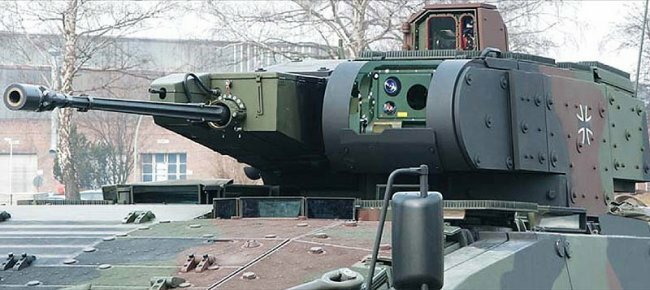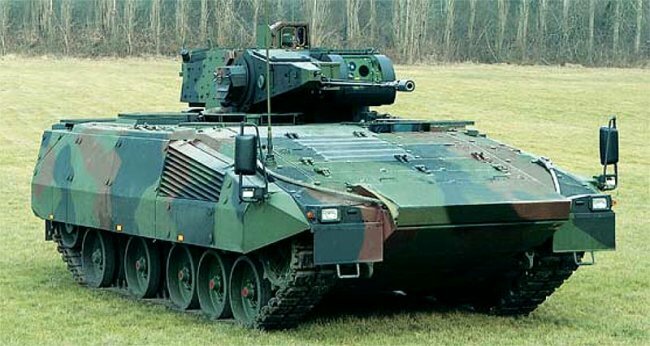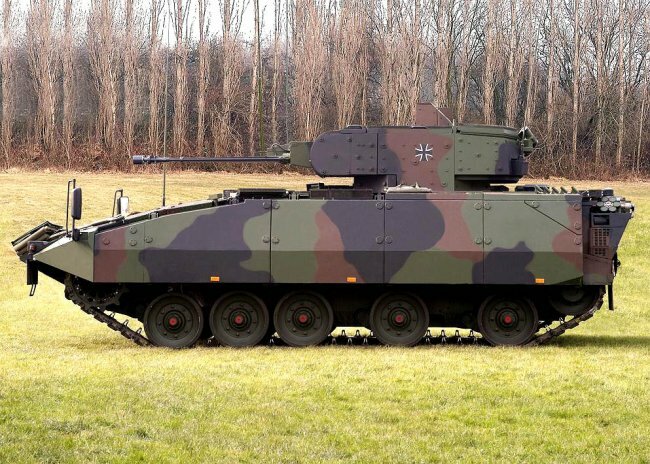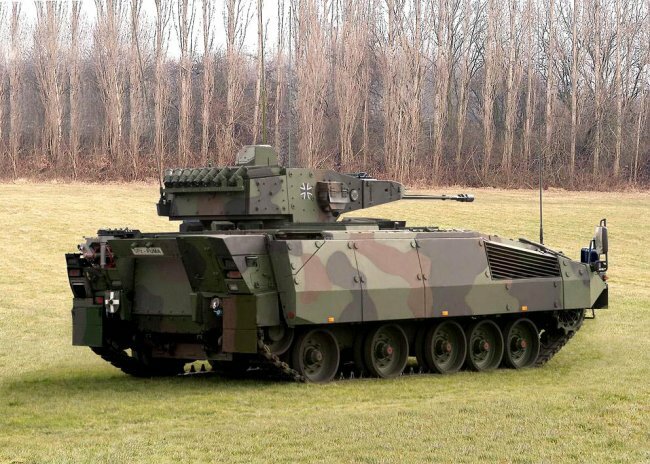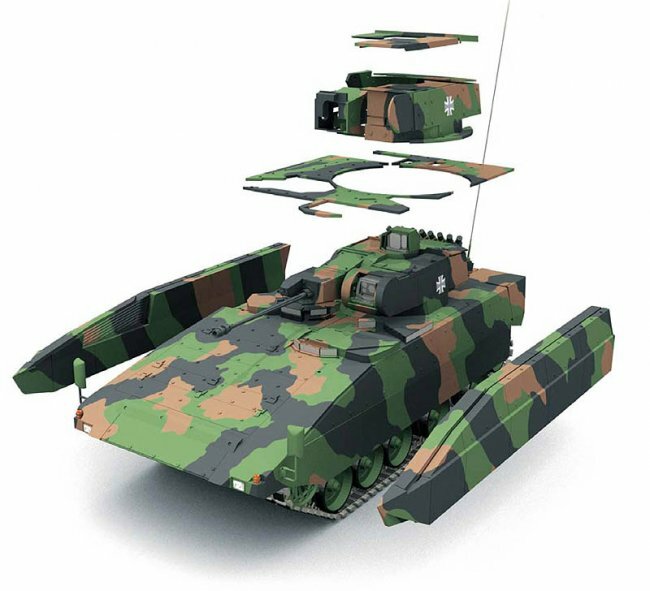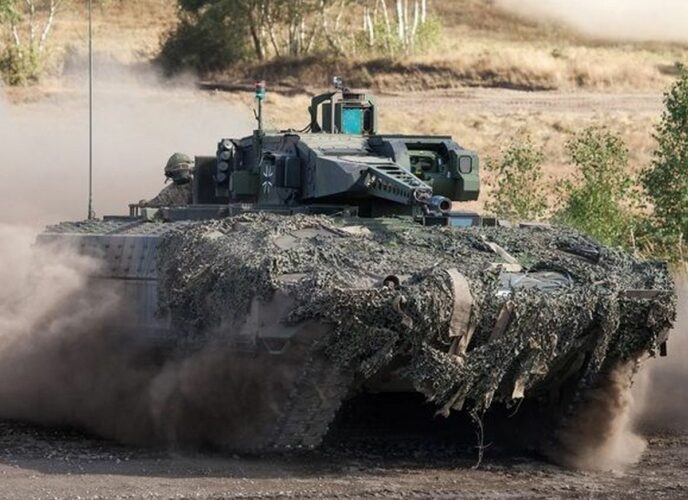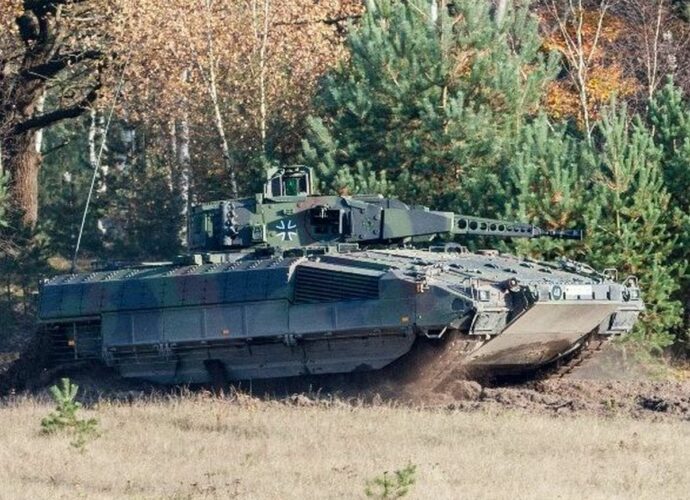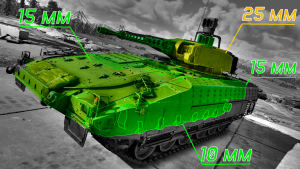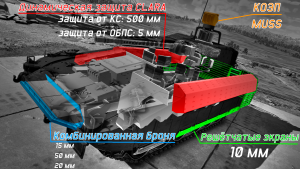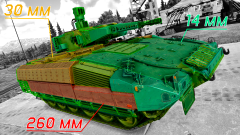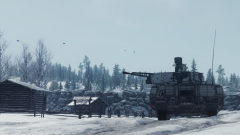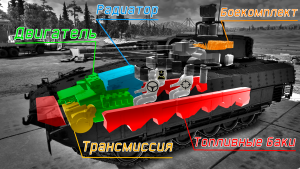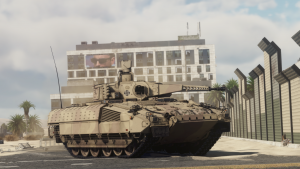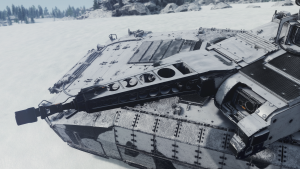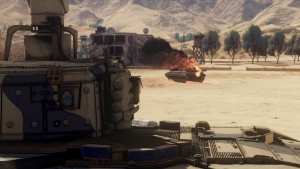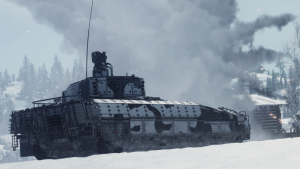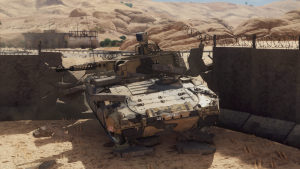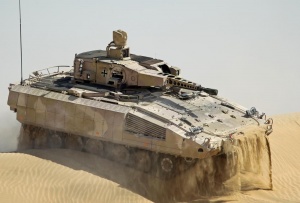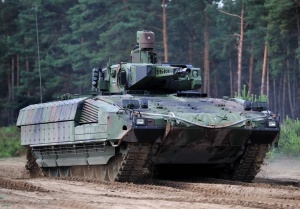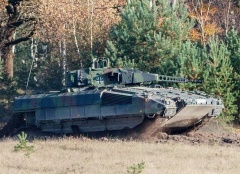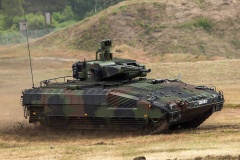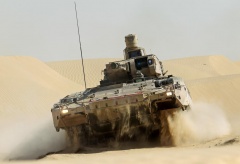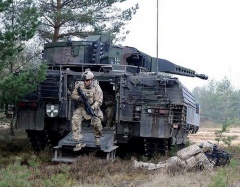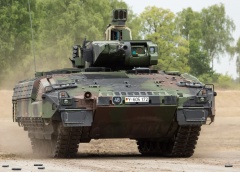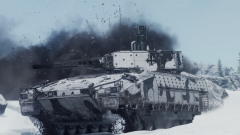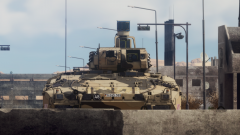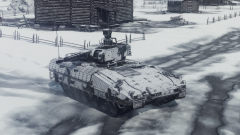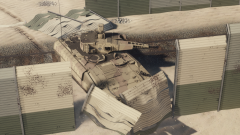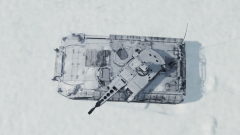БМП «Пума»
Для создания новой БМП была создана компания Projekt System und Management GmbH (PSM) в Касселе. Утверждение полностью отработанных тактико-технических требований состоялось 26 февраля 1998 года, но лишь в декабре 2005 года первая «Пума» увидела свет.
Новейшая германская БМП «Пума»
БМП «Пума» выполнена по классической для боевых машин пехоты схеме, но имеет некоторые особенности. Моторно-трансмиссионное отделение расположено в передней части машины и занимает примерно одну треть по длине ее корпуса. Механик-водитель размещен впереди слева по ходу машины, справа от него моторная перегородка силового отделения. За отделением управления и силовым отделением в корпусе машины находятся рабочие места командира и наводчика БМП: командир – справа, а наводчик – слева. Командир и механик-водитель имеют персональные люки в крыше корпуса БМП. Наводчик осуществляет посадку и высадку через люк командира.
Необитаемая башня с комплексом вооружения находится в центральной части корпуса машины со смещением влево, т.е. за спиной у наводчика. Вдоль правого борта за спиной у командира БМП расположены 4 сиденья десанта. Десантники располагаются спиной к правому борту. Еще два сиденья для десантников расположены вдоль левого борта машины сразу за башней. Они также размещаются спиной к левому борту. Крепление сидений выполнено к крыше корпуса машины.
Для посадки и высадки экипажа в корме машины имеется дверь с силовым приводом, открывающаяся назад вниз, превращаясь, таким образом, в аппарель. В крыше кормовой части БМП имеются два овальных люка, крышки которых открываются к центру машины. Бойниц для ведения огня из индивидуального оружия десанта не предусмотрено. Корпус машины сварной из катаных броневых листов. Ходовая часть имеет пятиопорную (на борт) подвеску, с расположением ведущего колеса спереди и направляющего колеса сзади. Подвеска индивидуальная, независимая, гидропневматическая.
Высокая защищенность («непревзойденная в своем классе» – по мнению разработчиков) БМП «Пума» обеспечивается комплексом пассивных и активных средств.
Предусматривается три уровня защиты машины: вариант «А» (авиатранспортабельный), вариант с повышенным уровнем защиты и вариант «С» (боевой).
В варианте «А» боевая масса машины составляет 31,45 т, что обеспечивает перевозку БМП по воздуху с использованием транспортных самолетов А400М. Броневой корпус боевой машины обеспечивает защиту от поражения пулями крупнокалиберных пулеметов и крупнокалиберных снайперских винтовок (калибром до 14,5 мм) во всех проекциях. В лобовых проекциях броневая защита «Пумы» должна держать попадания 30-мм снарядов автоматических пушек и гранат ручных противотанковых гранатометов. Правда, при этом не уточняется, каких гранат и из каких гранатометов. Хорошо известно, что современные выстрелы для гранатометов способны пробивать даже лобовую броню современных танков.
В варианте «С» боевая масса машины составляет 43 т. В этот вариант машина переводится путем навески на нее специальных броневых модулей. Они устанавливаются как на лобовые детали корпуса и башни «Пумы», так и на бортовые и кормовые, а также на крышу корпуса. При этом в случае поражения любой из модулей может быть быстро заменен. В варианте «С» обеспечивается защита экипажа и систем от попадания 30-мм подкалиберных снарядов автоматических пушек и гранат ручных противотанковых гранатометов не только в лобовые, но и в бортовые проекции машины. Все остальные проекции обеспечивают защиту от попадания пуль крупнокалиберных пулеметов и крупнокалиберных снайперских винтовок (калибром до 14,5 мм).
Кроме того, в обоих вариантах защиты гарантируется выживание экипажа при подрыве на противотанковых минах. Только опять же не указывается, какой мощности эти мины и какого действия.
Варианты усиления бронирования
Для повышения выживаемости машины на поле боя БМП оснащена системой предупреждения о лазерном облучении. Благодаря комплекту датчиков этой системы может быть обнаружено не только излучение лазерных дальномеров, но также, как сообщается, пуск ракет или выстрелы из пушек. Автоматика системы обеспечивает отстрел аэрозольных гранат для маскировки, а также дает направление в сторону угрозы, с целью открытия огня по угрожающему БМП объекту.
Защиту машины повышают также высокие разведывательные возможности БМП. Благодаря установке низкоуровневых телекамер на бортах и корме корпуса и башни обеспечивается постоянное наблюдение на 360° вокруг машины. Изображение с телекамер поступает на жидкокристаллические мониторы командира и наводчика. Кроме того, по сообщениям разработчиков, с любого из призменных приборов наблюдения можно выдать целеуказание командиру об обнаруженной цели.
Командир машины ведет наблюдение через панорамный комбинированный прицел, установленный на крыше башни, имеющий стабилизированное в двух плоскостях поле зрения и переменную кратность его увеличения.
Для самозащиты на корме машины справа имеется шестиствольная пусковая установка 76-мм осколочных гранат. Эффективная дальность стрельбы из нее составляет от 30 до 65 м.
БМП «Пума» оборудована системой коллективной защиты от оружия массового поражения и системой обнаружения и тушения пожара.
Одним из требований к новой немецкой БМП было обеспечение ее подвижности на уровне основного боевого танка «Леопард-2». Учитывая немалую боевую массу БМП, решить эту задачу было возможно только при обеспечении высокой удельной мощности силовой установки.
В качестве силового агрегата для силовой установки БМП «Пума» использован 10-цилиндровый четырехтактный V-образный дизельный двигатель MTU 10V 892 HPD (High Power Density) с турбонаддувом, разработанный известной немецкой компанией MTU.
Дизель способен развивать мощность до 1000 л.с. при 4250 об/мин. Максимальный крутящий момент двигателя составляет 2070 Нм при 3200 об/мин. Такие характеристики силового агрегата обеспечивают машине удельную мощность до 34 л.с./т при уровне бронирования «А» и 25,3 л.с./т при уровне бронирования «С». Эти показатели позволяют БМП «Пума» развивать по шоссе скорость до 70 км/ч.
Дизель MTU 10V 892 HPD имеет два турбонагнетателя, обеспечивающие пятикратную степень сжатия подаваемого в двигатель воздуха. Система охлаждения двигателя жидкостная двухконтурная.
Двигатель оснащен системами электронного управления, электрофакельного пуска, для обеспечения запуска в условиях низких температур, и интегрированным стартер-генератором.
В едином блоке с дизелем смонтирована автоматическая коробка передач HSWL 256. Трансмиссия включает в себя гидротрансформатор с блокировочной муфтой и непосредственно коробку перемены передач, обеспечивающую переключение шести передач для движения вперед и одной заднего хода, систему поворота машины, тормозную систему и систему управления трансмиссией.
Управление трансмиссией электрогидравлическое, поэтому не требует больших физических усилий при вождении машины. Переключение передач при движении осуществляется автоматически.
Высокие скорости БМП «Пума», особенно по пересеченной местности, обеспечиваются и новой ходовой частью. Ее особенность в том, что она собирается отдельно от корпуса машины и представляет собой отдельную конструкцию, причем для каждого борта. Затем к каждому борту корпуса эти конструкции крепятся через резиновые элементы, что значительно снижает уровень вибраций в машине и шумность. Так решены сразу две задачи: снижена утомляемость экипажа и выход из строя приборов и агрегатов.
По мнению разработчиков, такая конструкция подвески не только позволяет увеличить полезный объем внутри корпуса БМП, но и снижает риск поражения находящихся внутри членов экипажа и десанта разлетающимися деталями подвески при подрывах на минах.
Необитаемая башня с комплексом вооружения
Высокую огневую мощь БМП «Пума» обеспечивают современные система управления огнем, мощное вооружение, электромеханический стабилизатор и другие системы.
В качестве основного оружия на БМП «Пума» используется 30-мм автоматическая пушка Rheinmetall Waffe Munition MK 30-2/АВМ.
Она имеет двухленточное питание и использует стандартные натовские боеприпасы 30х173 мм. В боекомплекте имеются бронебойные подкалиберные боеприпасы APFSDS-T и осколочные с дистанционным подрывом KETF, иногда называемые АВМ. По данным разработчиков, пушка способна поражать бронированные цели одиночными выстрелами и очередями на дальностях до 3000 м. Темп стрельбы очередями составляет 200 выстрелов в минуту. Начальная скорость полета снаряда APFSDS-T составляет 1385 м/с, а снаряда KETF – 1100 м/с.
Разработчики считают, что на дальностях до 3000 м из пушки МК 30-2/АВМ можно успешно вести борьбу со всеми типами бронированных целей, поражая их приборы прицеливания, наблюдения, датчики, находящиеся снаружи. Также имеется возможность вести борьбу с вертолетами и живой силой противника, небронированными целями, используя KETF снаряды. Эти снаряды имеют внутри 162 вольфрамовых цилиндрических осколка массой по 1,24 г.
Боекомплект пушки в БМП «Пума» составляет 400 выстрелов, уложенных в 4 ленты. Две ленты (200 выстрелов) находятся в нише башни в специальном магазине и готовы к использованию, а еще две – в корпусе машины.
Вспомогательным оружием является 5,56-мм пулемет MG4. Боекомплект составляет 2000 патронов в двух лентах. Одна лента готова к использованию, другая находится в укладке.
В качестве дополнительного оружия у БМП «Пума» имеется шестиствольная гранатометная установка, смонтированная в корме машины с левой стороны. Она предназначена для ведения стрельбы 76-мм осколочными гранатами для поражения живой силы противника на дальностях до 50 м, внезапно появившейся сзади машины.
Для постановки аэрозольных завес на башне имеется 8 пусковых установок дымовых (аэрозольных) гранат, объединенных в две группы.
БМП «Пума» оснащена современной автоматизированной системой управления огнем (СУО), которая интегрирована в командную систему управления – IFIS (Integrated Combat Forces Command and Weapon Control System).
Непосредственно в ее состав входят комбинированный прицельный комплекс наводчика WAO, панорамный командирский прицел PERI RTWL-B, бортовой компьютер с интерфейсом, органы управления, видеомониторы, датчики условий стрельбы. СУО сопряжена с цифровым полностью электрическим двухплоскостным стабилизатором вооружения.
Оптоэлектронный прицельный комплекс наводчика WAO имеет независимую стабилизацию поля зрения в двух плоскостях.
Как и на всех последних разработках образцов бронетехники, в БМП «Пума» серьезное внимание было уделено повышению эффективности командной управляемости. Машина оснащена автоматизированной системой управления войсками и оружием IFIS (Integrated Combat Forces Command and Weapon Control System). Она обеспечивает гарантированное прохождение потока информации для управления боевыми подразделениями от батальона, роты, взвода и отделения до отдельной боевой машины (танка или БМП). АСУ, используемая в БМП «Пума», обеспечивает:
• использование сетей подсистем для управления, информирования, связи, управления оружием, в том числе и при нахождении за пределами машины;
• способность управлять необитаемыми аппаратами, как в воздухе, так и на земле;
• возможность совершенствования и наращивания дополнительными составляющими компонентами командной сети управления. Из сильных сторон БМП «Пума» следует отметить высокую защищенность (по сравнению с другими образцами БМП, а не машин, сравнимых по массе), высокие показатели эффективности стрельбы из автоматической пушки, достигнутые за счет использования совершенных систем управления комплексом вооружения и новых боеприпасов, в том числе с дистанционным подрывом, высокую подвижность, современные технологии технического и тылового обеспечения, высокую командную управляемость.
Но все же машина не лишена недостатков. Один из них – большая боевая масса. В варианте «С» БМП «Пума» в 1,5 – 2 раза тяжелее других образцов БМП и сравнима с российской БМПТ. Вместе с тем она остается уязвимой перед РПГ (хотя разработчики утверждают обратное). Судя по опыту последних локальных конфликтов, именно реактивными противотанковыми гранатами наносится поражение большей части боевых машин. Следовательно, увеличение массы БМП «Пума» неоправданно. Кроме того, нет данных о подвижности этой «Пумы» на тяжелых грунтах.
Другой недостаток – отсутствие возможности борьбы с танками и другими бронированными боевыми машинами с высокой защищенностью. На БМП «Пума» отсутствует комплекс управляемого ракетного вооружения.
Вспомогательного оружия в виде спаренного с пушкой 5,56-мм пулемета MG4, использующего автоматные патроны, явно недостаточно для боевой машины. Недостаточен и боекомплект автоматической пушки, готовый к использованию, – всего 200 выстрелов. Имеющиеся еще 200 выстрелов необходимо загружать в магазины системы питания боеприпасами только при выходе экипажа из машины.
К недостаткам можно отнести – отсутствие механических дублирующих систем для управления комплексом вооружения.
Наши новостные каналы
Подписывайтесь и будьте в курсе свежих новостей и важнейших событиях дня.
Новости
Дзен
Телеграм
«Правый сектор» (запрещена в России), «Украинская повстанческая армия» (УПА) (запрещена в России), ИГИЛ (запрещена в России), «Джабхат Фатх аш-Шам» бывшая «Джабхат ан-Нусра» (запрещена в России), «Талибан» (запрещена в России), «Аль-Каида» (запрещена в России), «Фонд борьбы с коррупцией» (запрещена в России), «Штабы Навального» (запрещена в России), Facebook (запрещена в России), Instagram (запрещена в России), Meta (запрещена в России), «Misanthropic Division» (запрещена в России), «Азов» (запрещена в России), «Братья-мусульмане» (запрещена в России), «Аум Синрике» (запрещена в России), АУЕ (запрещена в России), УНА-УНСО (запрещена в России), Меджлис крымскотатарского народа (запрещена в России), легион «Свобода России» (вооруженное формирование, признано в РФ террористическим и запрещено)
«Некоммерческие организации, незарегистрированные общественные объединения или физические лица, выполняющие функции иностранного агента», а так же СМИ, выполняющие функции иностранного агента: «Медуза»; «Голос Америки»; «Реалии»; «Настоящее время»; «Радио свободы»; Пономарев; Савицкая; Маркелов; Камалягин; Апахончич; Макаревич; Дудь; Гордон; Жданов; Медведев; Федоров; «Сова»; «Альянс врачей»; «РКК» «Центр Левады»; «Мемориал»; «Голос»; «Человек и Закон»; «Дождь»; «Медиазона»; «Deutsche Welle»; СМК «Кавказский узел»; «Insider»; «Новая газета»
| Puma | |
|---|---|
 |
|
| Type | Infantry fighting vehicle |
| Place of origin | |
| Service history | |
| In service | 2015 – present |
| Used by | |
| Production history | |
| Designer | Krauss-Maffei Wegmann Rheinmetall Landsysteme |
| Designed | 1995 – 2009 |
| Unit cost | 1st batch: €17.14 million [1] 2nd batch: €22 million (order 2023) [2] |
| Produced | 2009 – present |
| No. built | 350 as of December 2022[3][4] |
| Specifications | |
| Mass |
|
| Length | 7.4 m (24 ft) [6] |
| Width | 3.7 m (12 ft) with base armour 4.0 m (13 ft) up-armoured [7] |
| Height | 3.1 m (10 ft) for the turret roof 3.6 m (12 ft) for the optics [5] |
| Crew | 3 |
| Passengers | 6 |
|
|
|
| Armor | AMAP modular composite armor[8] composite armour |
|
Main |
Autocanon MK 30-2/ABM [de] (30 mm, 200 rounds ready to fire, 200 in storage) |
|
Secondary |
Base variant:
S1 variant:
|
| Engine | MTU Fried. MT 892 Ka-501 [de] v10 11.1-litre 1,088 PS (800 kW) (at 3,800 rpm), 2,200 N⋅m (1,623 ft⋅lb) [7][6] |
| Power/weight | 18.6 kW/t[5] |
| Transmission | Renk HSWL 256 |
| Suspension | Horstman hydrostruts |
| Fuel capacity | 900 L (240 U.S. gal; 200 imp gal) |
|
Operational |
600 km (373 mi) on road [7] |
| Maximum speed | 70 km/h (43 mph) on road [7] |
The Puma is a German infantry fighting vehicle (IFV) (Schützenpanzer or short SPz) designed to replace the aging Marder IFVs currently in service with the German Army. Production of the first batch of 350 vehicles began in 2010 and was completed in August 2021. A second batch of 229 Pumas received funding.[9] Mass production began on 6 July 2009.[10] The companies responsible for this project are Krauss-Maffei Wegmann and Rheinmetall Landsysteme, which created a joint venture, Projekt System Management GmbH (PSM). The Puma is one of the world’s best-protected IFVs, while still having a high power-to-weight ratio.[11][12]
History[edit]
Development[edit]
The Puma (formerly also named Igel (hedgehog) and Panther)[13][14] started as a follow-up project to the German 1996 «NGP» project (Neue Gepanzerte Plattformen, «New Armored Platforms»). Its aim was to collect ideas for a common base vehicle that could be used for a variety of tasks including that of the APC, IFV, air defense and replacing and assisting the MBT in the frontline combat role. The NGP project was ended in 2001.
The lessons learned were incorporated into the new tactical concept named neuer Schützenpanzer («new IFV») in 1998. Planning for the Puma as the successor of the Marder began in 2002.[5] That same year, the German Army (Heer) placed an order for the delivery of five pre-production vehicles and their logistics and training services at the end of 2004. On 8 November 2007, a budget of €3 billion to acquire 405 Pumas (excluding the five Pumas that had already been delivered to the German Army for trials) was agreed upon.[15]
On 6 December 2010, the first two serial vehicles were handed over to the German Bundesamt für Wehrtechnik und Beschaffung.[16]
The Puma successfully completed cold tests in Norway in 2012. In August 2013, two Pumas were airlifted to the United Arab Emirates for hot weather tests. Trials included suitability for hot weather operations, firing and driving maneuvers in desert conditions, as well as firepower and mobility evaluations. During the trials, the temperature profiles inside the vehicle were measured, then compared to the ambient temperature.[17]
On 13 April 2015, the Federal Office of Bundeswehr Equipment, Information Technology and In-Service Support (BAAINBw) granted authorization of use of the Puma IFV. This began a program to «train the trainers» on the first seven vehicles and additional ones until the end of the year, when a training center will be set up to put Panzer Grenadiers of mechanized infantry companies through a three-month course to familiarize them with their Pumas.[18] The Puma officially entered service with the German military on 24 June 2015.[19]
Future[edit]
Given the advanced age of the current Marder IFVs, and because the world market does not offer any vehicle comparable with the specifications to which the Puma is built, the acquisition of the new vehicles was unanimously voted for by the budget committee of the Bundestag.
350 Pumas were delivered to replace the more than 40-year-old Marders.[3][4] Full operational readiness was to be achieved by 2024.[5]
The German Army will use €500 million to modernize 40 Pumas by 2023, with more effective weaponry and communications technology capable of rapidly providing a situation image and GPS coordinates to fighter jets.[20] This variant was cleared for operations in March 2021, after successfully completing the army’s tactical evaluation in its second attempt.[21] The German contribution to the NATO VJTF in 2023 is intended to include Pumas to this standard.
There are provisions for hard- or soft-kill systems to defeat hostile ATGMs or RPGs, or for future active/reactive armor. There are also mounts and interfaces for the inclusion of ATGMs on the right side of the turret.
The Puma’s large weight reserves and the compact cabin make it very attractive for modification. Most vital integrals are situated in the front, floor, and side walls, which may remain unchanged during such a cabin-oriented modification.
On 28 June 2021, BAAINBw awarded the Rheinmetall-KMW joint venture PSM a EUR1.04 billion (US$1.23 billion) contract to upgrade 154 German Army Pumas to the S1 enhanced design status. The upgrade includes equipping the Puma with the Mehrrollenfähiges leichtes Lenkflugkörper-System (Multirole-capable Light Missile System: MELLS, the Bundeswehr’s designation for the Spike-LR), integrating a turret-independent secondary weapon system, new digital radios, high-resolution day/night cameras for the driver and mounted squad, color-enabled optronics for the gunner and commander, and connecting the vehicle with the Infanterist der Zukunft — Erweitertes System (Future Soldier — Expanded System, IdZ-ES) and battle management system. The contract is scheduled for completion by 2029; an option to upgrade another 143 Pumas is included, which combined with the 40 already upgraded would bring all but 13 driver training vehicles in the German Army’s inventory to S1-standard.[22] That option was approved in December 2022.[23]
In March 2022 the funding for a second batch of 229 Pumas of the latest standard was secured.[9]
Eighteen Pumas took part in exercises in 2022, and all of them were inoperable at the end of the exercises.[24] Major General von Butler, the commander of the 10th Armoured Division, described the situation as a «total failure.»[25][26] Consequently, the German government paused purchases of further Pumas.[3]
The manufacturer described the damage as «minor damage» which «was caused by the crew through improper operation»
[27]
In May 2023, another batch of 50 Pumas was ordered.[28]
Design[edit]
The Puma, while externally not very different from existing IFVs, incorporates a number of advances and state-of-the-art technologies. The most obvious of these is the incorporated ability to flexibly mount different armour (see below for details). Another feature is the compact, one-piece crew cabin that enables direct crew interaction («face-to-face»; like replacing the driver or gunner in case of a medical emergency) and minimizes the protected volume.[5] The cabin is air conditioned, NBC-proof with internal nuclear and chemical sensors and has a fire suppressing system using non-toxic agents. The engine compartment has its own fire extinguishing system. The only compromise of the otherwise nearly cuboid cabin is the driver station, located in a protrusion in front of the gunner, in front of the turret.
One measure to achieve the one-piece cabin is the use of an unmanned, double-asymmetrical turret (see photo): while slightly off-center turrets are common in IFVs, the Puma’s turret is on the left-hand side of the vehicle, while the main cannon is mounted on the right side of the turret and thus on the middle axis of the hull when the turret is in the forward position.
The outer hull (minus the turret) is very smooth and low to minimize shot traps and the general visual signature. The whole combat-ready vehicle in its base configuration will be air transportable in the Airbus A400M tactical airlifter.[5] Its 3+6 persons crew capability is comparable to other vehicles of comparable weight, like the US American M2 Bradley IFV, the Marder, and the CV9040, but smaller than the 3+8 of the CV9030 and CV9035.
Armament[edit]
Cannon[edit]
The primary armament is a Rheinmetall 30 mm MK 30-2/ABM (Air Burst Munitions) autocannon, which has a rate of fire of 200 rounds per minute and an effective range of 3,000 m.[5] The smaller 30×173mm cartridge offers major advantages over, for example, the Bofors 40 mm gun mounted on the CV9040 because of a much lower ammunition size and weight. The belt feed system provides a large number of rounds ready to fire, while the 40mm offers only 24 shots per magazine. This is not a problem in a CV9040, but would force the Puma off the battlefield to reload the unmanned turret.
There are currently two ammunition types directly available via the autocannon’s dual ammunition feed. One is a sub-calibre, fin-stabilised APFSDS-T (T for tracer), with high penetration capabilities, mainly for use against medium armoured vehicles. The second is a full-calibre, multi-purpose, Kinetic Energy-Timed Fuse (KETF) munition, designed with a fuse setting allowing air burst capability for ejecting a cone of sub-munitions. The ammunition type can be chosen shot-to-shot, as the weapon fires from an open bolt, with no cartridge inserted until the trigger is depressed. The ammunition capacity is 400 rounds; 200 ready to fire and 200 in storage.
Anti-tank guided missile[edit]
To combat main battle tanks, helicopters, and infrastructure targets such as bunkers, the German Puma vehicles will be equipped with a turret-mounted EuroSpike Spike LR missile launcher, which carries two missiles.[29] The Spike LR missile has an effective range up to 4,000 m and can be launched in either the «Fire and Forget» or «Fire and Observe» mode.
Machine gun[edit]
Keeping the weight within the 35-ton limit also led to a smaller calibre for the secondary armament, a coaxially mounted 5.56 mm HK MG4 machine gun firing at 850 rounds per minute and with an effective range of 1,000 m. The ammunition capacity is 2,000 rounds; 1,000 ready to fire and 1,000 in storage. While this is a smaller weapon than the western standard secondary armament (7.62 mm caliber MG), it offers the advantage that the crew can use the ammunition in their individual firearms. In situations where the lower range and penetration of the 5.56 mm rounds is an issue, the high ammunition load of the main gun enables the vehicle crew to use one or two main gun rounds instead. The gun housing can also host the 7.62 mm MG3. The MG4 is being replaced by the MG5 with the S1 variant.[5]
Grenade launcher[edit]
In addition to the usual smoke-grenade launchers with 8 shots, there is a multishot 40 mm launcher at the back of the vehicle for close-in defence. The main back door can be opened halfway and enables two of the passengers to scout and shoot from moderate protection.
Protection[edit]
There is a single compartment for the whole crew, including the driver, and the turret is unmanned, which enabled the German Army to reach an impressive protection level, and for the driver, it means that there are safe ways to exit the vehicle if needed.
Passive protection / Armour[edit]
The Puma was designed to accommodate additional armor, initially planning to offer three protection classes which are wholly or partly interchangeable. Protection class A is the basic vehicle, at 31.5 metric tons combat-ready weight air transportable in the A400M. Protection class C consists of two large side panels that cover almost the whole flanks of the vehicle and act as skirts to the tracks, a near-complete turret cover and armor plates for most of the vehicle’s roof. The side panels are a mix of composite and spaced armor. It adds about 9 metric tons to the gross weight. Originally, there was also a protection class B designed for transport by rail. However, it became obvious that class C lies within the weight and dimension limits for train/ship transportation, thus class B was scrapped.
The Puma is protected by AMAP composite armor, the AMAP-B module is used for protection against kinetic energy threats, while
AMAP-SC offers protection against shaped charges.
A group of four A400M aircraft could fly three class A Pumas into a theatre, with the fourth airplane transporting the class C armor kits and simple lifting equipment. The Pumas could be built-up to armor class C within a short time.
The basic armor can resist direct hits from 14.5 mm Russian rounds, the most powerful HMG cartridge[30] in common use today (and up to twice as powerful as the western de facto standard 12.7 mm .50 BMG cartridge).[31]
The frontal armor offers protection against medium caliber projectiles and shaped charge projectiles.[32] In protection class C, the flanks of the Puma are up-armored to about the same level of protection as is the front, while the roof armor is able to withstand artillery or mortar bomblets.
The whole vehicle is protected against heavy blast mines (up to 10 kg) and projectile charges from below, while still retaining 450 mm ground clearance. Almost all equipment within the cabin, including the seats, has no direct contact to the floor, which adds to crew and technical safety. All cabin roof hatches are of the side-slide type, which make them easier to open manually, even when they are obstructed by debris. The exhaust is mixed with fresh air and vented at the rear left side. Together with a special IR-suppressing paint, this aims at reducing the thermal signature of the IFV.
Active Protection System[edit]
The Pumas of the German Army will be equipped with a soft-kill system called Multifunktionales Selbstschutz-System (multifunction self protection system), MUSS, which is capable of defeating ATGMs.[33]
Other protection features[edit]
The engine compartment and the crew compartment are equipped with a fire suppression system.
The crew compartment is equipped with a full NBC system.[34]
Another crew safety measure is that the main fuel tanks are placed outside of the vehicle hull itself, mounted heavily armoured within the running gear carriers. While this may pose a higher penetration risk to the tanks, it is unlikely that both tanks will be penetrated at the same time, enabling the vehicle to retreat to a safer position in case of a breach. There is also a collector tank within the vehicle, which acts as a reserve tank in case of a double tank breach.
Sensors and situational awareness[edit]
The Puma offers improvements in situational awareness. The fully stabilized 360° periscope (PERI RTWL by Hensoldt) with six different zoom stages offers a direct glass optic link to either the commander or the gunner. Since this is an optical line, it had to be placed in the turret center, one of the reasons why the main cannon is mounted off-center on the turret. Via an additional CCD camera the picture from this line can also be fed into the on-board computer network and displayed on all electronic displays within the vehicle. Besides that, the periscope offers an optronic thermal vision mode and a wide-angle camera with three zoom stages to assist the driver, as well as a laser range finder. The whole array is hunter-killer capable. The commander also has five vision blocks.
The gunner optics, which can be completely protected with a slide hatch, are mounted coaxially to the main gun. The gunner has a thermal vision camera and laser range finder (identical to those on the PERI) and an optronic day sight, rounded off with a glass block. The driver has three of vision blocks, as well as an image intensifier and a display for optronic image feeds. The passenger cabin has a hatch and three vision blocks on the rear right side of the vehicle, one of them in a rotary mount. The rear cabin also has two electronic displays.
All in all, the Puma has an additional five external cameras at its rear in swing-mounts for protection while not in use. Apart from the glass optic periscope view directly accessible directly by the commander and gunner and indirectly via the CCD camera, all optronic picture feeds can be displayed on every electronic display within the vehicle. The provisions for the rear cabin enable the passengers to be more active than previously in assisting the vehicle crew either directly through the vision blocks and hatches, or by observing one or more optronic feeds. The whole crew has access to the onboard intercom.
R&S SOVERON Handheld and Vehicel application have been commissioned to equip Pumas of the German element of Very High Joint Readiness Task Force 2023 (VJTF 2023).[35]
Mobility[edit]
Traditionally, IFVs are expected to interact with main battle tanks (MBTs) on the battlefield. In reality, many IFVs are not mobile enough to keep up with the pace of an MBT. The Puma aims to close this gap with several key technologies. Firstly, its compact, lightweight MTU Diesel engine is unusually strong at 800 kW nominal output. Even at the 43 t maximum weight in protection class C, it has a higher kW/t ratio than the Leopard 2 MBT it is supposed to supplement.
The vehicle prototypes have a five-road wheel decoupled running gear, and use a hydropneumatic «In Arm» Horstmann suspension to improve cross-country performance while reducing crew and material stress by limiting vibrations and noise. The road wheels are asymmetrical, mounted closer to each other at the front. This is to counter the front-heavy balance, inevitable because of the heavy frontal armor as well as the engine and drive train which are also situated at the front. The 500mm-wide steel tracks made by Diehl Defence are of new construction and lighter than previous designs.
The serial production vehicles will have a symmetrical arranged six road wheel running gear as shown on released pictures by the manufacturer.[36]
In December 2023, 53 reserve engines were ordered as spare parts in order to enable the maintenance of the existing engine without decreasing the availability. The engine require a heavy maintenance every 10 years, or 1,000 operating hours or every 10,000 km. [37]
Operators[edit]
|
|
This section needs to be updated. Please help update this article to reflect recent events or newly available information. (August 2015) |
Current operator[edit]
Germany (350 active, 50 on order, option for 179 as of 2023)
The Puma has been in service with the German Army since April 2015. 350 vehicles have been delivered as of August 2021. Originally 405 were ordered, but on 11 July 2012 the order was reduced to 350.
In March 2022 the German Army secured financing for a second batch of 229 Pumas. Puma orders were paused in December 2022 due to reliability issues, according to then defense minister Christine Lambrecht.[38] In May 2023, a second order for 50 Puma (€1.1 billion) was confirmed. It is to be delivered from end of 2025, until beginning of 2027.[28]
Failed bids[edit]
Australia
The Australian Army sought a ‘Mounted Close Combat Capability’ within its Land 400 Phase 3 procurement program. The Puma IFV was one of the potential contenders. In November 2018, Project System & Management GmbH (PSM), the joint venture between Krauss-Maffei Wegmann and Rheinmetall announced the Puma would not compete in the Land 400 Phase 3 project.[39]
Canada
The Department of National Defence was considering the purchase of vehicles meant to accompany the Leopard 2 into combat. The CV90, the Puma and the Véhicule blindé de combat d’infanterie were the most likely candidates for the role. A contract of 108, with an option for up to 30 more was looked at.[40][41][42][43] The project has since been cancelled.
Chile
Offered by the German Army to supplement the Leopard 2 and the possibility of manufacturing it under license by FAMAE, but the German offer didn’t lead to any discussion for a purchase.[44]
Croatia
In 2016, the Croatian Army was looking at replacing the 128 M80A IFV that were in its inventory. Several contenders were considered, including the CV90 and the Puma. 108 vehicles were expected (88 IFV, 8 command and control vehicles, 8 armoured ambulances, and 4 driving training vehicles). It was expected to be purchased from 2021.[45]
For budget reasons, the Croatian Army settled on 89 M2A2 Bradley (ODS variant) for $145.3 million. The Croatian Army decided its purchase in 2020, and the contract was signed in January 2022. It includes 62 fully equipped and fully restored (M2A2 ODS), 5 for training, 22 for spare parts, they will be delivered in 2023-26.[46]
Czech Republic
Czech Army is looking to buy 210 new infantry fighting vehicles for €2 Bln. between 2019 and 2024. All of them will replace aging BMP-2 in IFV and supporting variants. There will probably be an option to 100 more vehicles. In June 2017 five types of IFV (two versions of CV90, Lynx, ASCOD and Puma) were evaluated during a nine days testing.
Based on unofficial information from the Czech general staff, Puma might be selected based on its «technological superiority».[47] In December 2018, Puma was shortlisted together with the ASCOD, CV90 and Lynx[48] In October 2019 it was announced that the Puma was being withdrawn from the competition. The manufacturer said that the Czech Army requirements would require an expensive redesign to the existing Puma which it was unwilling to undertake.[49]
The Czech army selected the CV9030 MkIV in July 2022 and signed the contract in December 2022.[50]
Hungary
The Hungarian Defence Forces was looking to buy 200 new infantry fighting vehicles between 2020 and 2026. All of them were to replace the aging BTR-80 APCs.[51] Eventually the Hungarian government decided on the Lynx.[52]
United States
The United States Army sought a new family of vehicles to replace the aging fleet of M113 APCs and M2 Bradleys with the BCT Ground Combat Vehicle Program. With modification, the Puma satisfied the technical requirements of the BCT Ground Combat Vehicle Program and was offered by SAIC and Boeing.[53] The SAIC-Boeing team was not awarded a technology development contract for their Puma-based vehicle in August 2011, and then filed a protest. The protest was denied in December 2011 based on concerns over the vehicle’s force protection features, primarily the proposed active protection system and underbody armor, and 20 significant weaknesses which had potential solutions offered that were judged as inadequate.[54] On 2 April 2013, the Congressional Budget Office released a report that advised purchasing current infantry fighting vehicles instead of developing a new vehicle for the GCV program. Buying the Puma would save $14.8 billion, and was called the most capable vehicle.[55] The Army responded by saying no existing vehicle could match requirements to replace the Bradley.[56]
See also[edit]
- ASCOD – Austro-Spanish armoured fighting vehicle
- Ajax – Family of British armoured fighting vehicles
- Borsuk IFV – Polish infantry fighting vehicle
- M2 Bradley – American infantry fighting vehicle
- Warrior IFV – Current British infantry fighting vehicle
- Combat Vehicle 90 – Swedish Infantry fighting vehicle
- Dardo IFV – Italian infantry fighting vehicle
- K21 – South Korean infantry fighting vehicle
- ZBD-04 – Chinese infantry fighting vehicle
- Kurganets-25 – Russian infantry fighting vehicle
- Lynx – German armored fighting vehicle
- Makran IFV – Iranian infantry fighting vehicle
- Tulpar IFV – Turkish infantry fighting vehicle
- Hunter AFV – Singaporean armoured fighting vehicle
References[edit]
- ^ Carstens, Peter (18 March 2021). «Schützenpanzer Puma endlich einsatztauglich». faz.net. Retrieved 4 November 2021.
- ^ url=https://www.hna.de/kassel/bundeswehr-bestellt-50-puma-panzer-92289119.html#:~:text=Auftrag%20f%C3%BCr%201%2C1%20Milliarden%20Euro%3A%20Die%20Bundeswehr%20hat%20bei,knapp%201%2C1%20Milliarden%20Euro.
- ^ a b c «Germany pauses buying Puma tanks after mass breakdown». The Guardian. AFP. 19 December 2022.
- ^ a b «Bericht des BMVg zu Rüstungsangelegenheiten» (PDF). bmvg. Retrieved 2 April 2022.
- ^ a b c d e f g h i j «Der Puma: Einer der modernsten Schützenpanzer der Welt» (in German).
- ^ a b «PUMA IFV». knds.de. Retrieved 4 December 2023.
- ^ a b c d «Der Schützenpanzer Puma». www.bundeswehr.de (in German). 20 September 2017. Retrieved 20 November 2021.
- ^ «IBD Deisenroth Engineering: Products in use». IBD Deisenroth Engineering. Archived from the original on 12 June 2010. Retrieved 29 December 2010.
- ^ a b Redaktion, Soldat & Technik (14 March 2022). «Zweites Los Schützenpanzer Puma kommt». S&T — Soldat & Technik (in German). Retrieved 15 March 2022.
- ^ «Billion plus order for Rheinmetall: Go-ahead given for serial production of 405 Puma infantry fighting vehicles for the Bundeswehr». Rheinmetall Defense. 6 July 2009. Archived from the original on 7 October 2010.
- ^ «Puma IFV tracked armored Infantry Fighting Vehicle data fact sheet». www.armyrecognition.com. 13 May 2023.
- ^ «Puma». www.deagel.com. Archived from the original on 15 August 2020.
- ^ «Bundeswehr: Der Marder geht – der Igel kommt». Spiegel Online. 12 September 2002. Retrieved 7 November 2014.
- ^ «Rüstungspolitik: Scharping lässt den Panther ausrollen». Spiegel Online. 12 July 2005. Retrieved 7 November 2014.
- ^ «Puma Infantry Fighting Vehicle». www.military-today.com. Retrieved 9 September 2017.
- ^ «Serial start for new PUMA infantry fighting vehicle». psm-spz.com. PSM-SPZ.de. 7 December 2010. Archived from the original on 15 July 2011. Retrieved 29 December 2010.
- ^ «German army test its new armoured infantry fighting vehicle Puma in hot weather conditions». Army Recognition. 30 August 2013.
- ^ «Puma infantry fighting vehicle gets official approval for service in German army». Army Recognition. 20 April 2015.
- ^ «German army takes officially delivery of Puma infantry fighting vehicle from Rheinmetall & KMW». Army Recognition. 24 June 2015.
- ^ «Neuer Bundeswehr-Panzer zu alt» (in German). Retrieved 24 April 2018.
- ^ «Optimiert: Der Puma VJTF auf dem Gefechtsfeld». www.bundeswehr.de (in German). 18 March 2021. Retrieved 25 May 2021.
- ^ Fiorenza, Nicholas (5 July 2021). «Bundeswehr awards contract to upgrade Puma IFVs». Jane’s Information Group. Archived from the original on 10 July 2021.
- ^ Fiorenza, Nicholas (19 December 2022). «Germany approves Puma retrofit, BvS10, and rifle procurement». Janes Information Services. Archived from the original on 26 December 2022.
- ^ Kohler, Berthold (19 December 2022). «Peinlich für Deutschland» [Embarrassing for Germany]. Frankfurter Allgemeine Zeitung (in German). Retrieved 20 December 2022.
- ^ Chacko, Joseph P (18 December 2022). «German Army Puma IFV meant for NATO rapid response force face technical issues». Frontier India. Retrieved 20 December 2022.
- ^ «Wieder Pannen beim Puma: Deutscher Hightech-Panzer ist ‘Totalausfall’» [Another Puma breakdown: German high-tech tank suffers ‘total outage’]. Euronews (in German). 19 December 2022. Retrieved 20 December 2022.
- ^ «Bericht: Deshalb fielen so viele Puma-Panzer bei Bundeswehrübung aus». www.t-online.de (in German). 24 January 2023.
- ^ a b «German Armed Forces Orders 50 More Puma Infantry Fighting Vehicles for €1.1 Billion». MilitaryLeak. 16 May 2023. Retrieved 17 May 2023.
- ^ «The PUMA: Armament» (in German). PSM-SPz.de. Retrieved 29 December 2010.
- ^ «Modern Firearms». Archived from the original on 2 September 2010. Retrieved 23 December 2014.
- ^ «Modern Firearms». Archived from the original on 29 November 2016. Retrieved 23 December 2014.
- ^ «AIFV Puma Overall Protection» (PDF). PSM-SPZ.de. Retrieved 29 December 2010.
- ^ «psm-spz.de: Protection». Retrieved 23 December 2014.
- ^ «Puma IFV SPz». Fighting-Vehicles.com. 13 March 2017. Retrieved 10 July 2023.
- ^ Valpolini, Paolo (6 October 2020). «SOVERON HR starts on road to success». EDR Magazine. Retrieved 27 November 2023.
- ^ «Krauss-Maffei Wegmann — Ihr Partner rund um Wehrtechnik». Archived from the original on 18 September 2009. Retrieved 15 September 2009.
- ^ «Neue Triebwerke für den Schützenpanzer Puma». www.dbwv.de (in German). Retrieved 4 December 2023.
- ^ More, Rachel (19 December 2022). «Germany pauses purchases of Puma tanks after operational problems». Reuters. Retrieved 21 January 2023.
- ^ Foss, Christpher F (2 November 2018). «Puma IFV will not compete in Australia’s Project Land 400 Phase 3». IHS Jane’s 360. London. Archived from the original on 2 November 2018. Retrieved 7 November 2018.
- ^ «Close Combat Vehicle» (Press release). Department of National Defence. 8 July 2009. Archived from the original on 16 September 2009. Retrieved 11 November 2009.
- ^ «Canada Looks to Upgrade Its Armor». Defense Industry Daily. 9 July 2009. Retrieved 11 November 2009.
- ^ David Pugliese (21 January 2010). «Plans for new fleet of armoured combat vehicles back on track». Global News. Archived from the original on 11 July 2011. Retrieved 25 May 2010.
- ^ Aviation week (28 January 2008). «Canada: First Export Customer of Germany’s Puma IFV?». Archived from the original on 21 March 2010. Retrieved 25 May 2010.
- ^ «Alemania ofrece el Puma a las Fuerzas Armadas de Chile». www.infodefensa (in Spanish). 4 April 2013. Retrieved 9 September 2017.[permanent dead link]
- ^ «The German Army Pumas disaster and the damaged prestige of the German industry». Defensa y Aviación. 19 December 2022. Retrieved 23 March 2023.
- ^ Victor, Nancy (28 January 2022). «Croatia Armed Forces to acquire 89 Bradley fighting vehicles». Army Technology. Retrieved 23 March 2023.
- ^ Otto, Pavel (23 August 2017). «Armáda chystá nákupy transportérů z Německa. Jediným problémem je jejich cena — E15.cz» [The army is planning to purchase transporters from Germany. The only problem is their price]. e15.cz (in Czech). Archived from the original on 27 September 2017. Retrieved 9 September 2017.
- ^ «Czech Republic; Four firms shortlisted in BVP armoured vehicle tender». Defense Market Intelligence. 19 December 2018. Archived from the original on 19 December 2018. Retrieved 19 December 2018.
- ^ Adamowski, Jaroslaw (18 October 2019). «Three bidders offer combat vehicles to Czech military, as German joint venture bows out». DefenseNews. Retrieved 20 October 2019.
- ^ Sharma, Soumya (22 December 2022). «BAE Systems, Sweden, Czech Republic sign MoU for new CV90». Army Technology. Retrieved 23 March 2023.
- ^ András, Kósa (3 April 2019). «Honvédségi célkeresztben kétszáz Puma» [Two hundred Puma in the Army’s crosshairs]. nepszava.hu (in Hungarian). Retrieved 31 January 2021.
- ^ Komuves, Anita; Zieminski, Nick (17 August 2020). «Hungary’s government and Rheinmetall to produce armored fighting vehicles in Hungary». Reuters. Retrieved 30 December 2023.
- ^ White, Andrew (21 May 2010). «GCV shortlist revealed». shephard.co.uk. Archived from the original on 25 May 2010. Retrieved 21 May 2010.
- ^ The Army’s Ground Combat Vehicle (GCV) Program: Background and Issues for Congress — Fas.org, 14 June 2013
- ^ Hoffman, Michael (3 April 2013). «GCV is worst choice to replace Bradley». DoD Buzz. Archived from the original on 7 April 2013.
- ^ Hoffman, Matthew (4 April 2013). «Army, industry slam CBO’s scathing GCV report». DoD Buzz. Archived from the original on 8 June 2013.
External links[edit]
Wikimedia Commons has media related to Puma (IFV).
- Puma Technical Data Sheet and pictures
- Manufacturer website
- Krauss-Maffei Wegmann´s Puma site (Manufacturer)
- Pictures
6 880
Проект БМП “Пума” призван значительно повысить боевые возможности мотопехоты бундесвера, обеспечив её мобильность и тесное взаимодействие с танковыми подразделениями на базе ОБТ “Леопард 2”. Вместе с тем, жесткие условия бюджетного финансирования оборонных расходов привели к тому, что войска приступили к освоению новой техники только в апреля 2015 г.

БМП “Пума” – текущее состояние дел
Как известно, БМП
“Пума” в перспективе заменит давно находящиеся на вооружении сухопутных войск Германии БМП
“Мардер”. По заявлениям командования бундесвера, в сравнении с ней новая
боевая машина
обладает выдающимися характеристиками.
В конструкции “Пумы”
заложены уникальные технические решения, позволившие реализовать требования
максимальной защищенности, повышенной огневой мощи и высокой тактической
мобильности. При этом, удалось сохранить ограничения, наложенные техническим
заданием в отношении верхнего предела веса машины.
Конструктивные особенности “Пумы” обеспечивают её совместимость с новыми разработками, реализуемыми в интересах сухопутных войск. В частности, речь идет о проекте перспективной боевой экипировки “Пехотинец будущего“, интеграции боевой машины в управляющую информационную систему сухопутных войск (Führungsinformationssysteme, FüInfoSys) и внедрении нового поколения тактических средств радиосвязи.
Болезни роста
Название проекта
“Пума” является аббревиатурой, которая с немецкого переводится как “бронемашина за минимальные расходы” (Panzer Unter Minimalem Aufwand, PUMA). Вместе с
тем,ход работ оценивается, как наиболее
затянувшийся по времени. Ситуацию иллюстрирует доклад министерства обороны о
реализации 15-ти перспективных проектов вооружений. Документ ежегодно, в марте
месяце, предоставляется комиссии по вопросам обороны бундестага Германии.
Правительство Германии определило сроком окончания поставок БМП “Пума” в войска 2020 г. Согласно данным на 1 марта 2018 г. (доклад за 2019 г. засекречен) с момента начала разработок в 1996 г. и по расчетам на 2020 г. общая продолжительность проекта превысит первоначальные плановые показатели по времени на 57 месяцев. По стоимости – на 55 процентов, или на 1 226 млн. евро. Одновременно, дополнительные затраты на доработки БМП и средства обучения составят 585 млн. евро.
Основными подрядчиками по
производству БМП “Пума” стали концерны “Краусс-Маффей
Вегманн” (Krauss–Maffei Wegmann, KMW) и
“Райнметалл Ландсистеме” (Rheinmetall–Landsysteme, RLS). Концепция машины основана на проекте “новой
бронированной боевой платформы” (Neue
Gepanzerte Plattform, NGP). Проект
предполагал создание универсальной гусеничной базы для различных систем
вооружения.
Несколько первых
демонстрационных образцов изготовили в 2005 г., а в 2006 г. передали в войска.
Дальнейшие тесты и испытания выявили многочисленные недостатки конструкции,
программного обеспечения и других элементов платформы. Их устранение привело к
затягиванию сроков и значительному росту расходов.
Реализация
Первые семь серийных БМП поступили в распоряжение учебного центра СВ в Мюнстере в апреле 2015 г. Специально для БМП “Пума” на базе центра развернули структуру по внедрению новой боевой техники в войска (Einführungsorganisation, EFO). В рамках этого подразделения с апреля 2015 г. началась подготовка инструкторов.
Согласно подписанным
договорам, промышленность поставит в сухопутные войска бундесвера 350 боевых
машин “Пума”. По планам к марту 2018 г. их количество в частях должно
насчитывать 237 машин. В реальности – только 199. Вместе с тем, в докладе 2018 отмечаются
усилия производителя по ликвидации отставания. Так, в 2017 г., вместо плановых
62 производитель передал бундесверу 71 машину.
Достижение полной боевой
готовности всего парка БМП “Пума” намечено на 2025 г.
Особенности конструкции
БМП “Пума” – это бронированная боевая машина пехоты с необитаемой дистанционно управляемой башней. В своей базовой комплектации машина пригодна для перевозки новым военно-транспортным самолетом ВВС Германии Airbus A400M. Общая компоновка БМП разработана с акцентом на боевое применение экипажа в сочетании с тактической пехотной группой.
Экипаж в составе трех человек
(командир отделения, наводчик-оператор систем вооружения, механик-водитель)
постоянно находятся в машине. Тактическая группа включает командира и пять пехотинцев: пулеметчика,
гранатометчика, снайпера и двух стрелков. В исключительных случаях за счет
командира отделения численность тактической группы увеличивается до семи
человек. Тогда экипаж БМП возглавляет наводчик-оператор.
Тактическая группа действует как из десантного отделения машины,
так и в пешем строю. Благодаря сплошному внутреннему боевому пространству,
возможно прямое общение всего личного состава, находящегося на борту.
Размещение экипажа и десанта
В машине механик-водитель находится
спереди слева. За ним располагается наводчик-оператор. Он управляет оружейной
установкой и сидит перед поворотным механизмом башни. Место командира отделения
со сдвижным люком – справа от наводчика. Благодаря асимметричному расположению
башни на левой стороне машины, командир отделения может общаться с тактической
группой в десантом отсеке машины.
Личный состав десанта сидит
спиной к внешним бортам машины: четыре пехотинца справа и два слева. Центральная
полка под башней служит местом для хранения снаряжения. Всё внутреннее
оснащение выполнено в противоминном стиле и не имеет контакта с дном корпуса
БМП.
Размер десантного отсека
увеличен, что позволило разместить люк на крыше для двух человек и улучшить
защищенность машины с тыла. В задней двери оборудовано окно из
пуленепробиваемого стекла, которое с внутренней стороны закрыто заслонкой из
листовой стали.
Система защиты БМП “Пума”
Броня “Пумы”
является модульной и имеет два уровня защиты. Вариант защиты “А”
является наименьшим, но позволяет выполнять транспортировку машины
военно-транспортным самолетом Airbus A400M. В этом случае масса БМП с навесным
оборудованием не превышает 32 т., причем вес, перевозимого дополнительного
оборудования, ограничивается 1 т.
На уровне “А” БМП
“Пума” с фронта защищена от переносного противотанкового оружия
(например, РПГ-7), снарядов среднего калибра (до 30 мм), артиллерийских
осколков, а также от тяжелых мин весом до 10 кг.
Уровень защиты “C”
(боевой) достигается применением дополнительного модульного бронирования. Оно включает
в себя защиту башни, фронтальную защиту, бронирование бортов и крыши. В
результате, по данным производителя, БМП способна противостоять противотанковым
средствам, снарядам среднего калибра и авиационным кассетным боеприпасам (Bombletts).
Кроме того, серийные БМП с
уровнем защиты “C” оборудуются реактивной броней (ERA) от компании
Dynamit Nobel Defense Group. Дополнительные боковые юбки покрывают привод до
середины катков. Бундесвер закупил в общей сложности 200 комплектов. Вес одного
комплекта составляет 1 т и содержит 500 кг взрывчатки. Время на установку реактивной брони достигает 3 – 4 часов.
БМП “Пума” оснащена
системой защиты от ОМП производства компании Dräger. Выхлопные газы смешиваются
со свежим воздухом и выбрасываются слева от шасси, чтобы уменьшить инфракрасную
сигнатуру. Дальнейшее снижение инфракрасного излучения достигается с помощью
соответствующего камуфляжного покрытия.
На БМП дополнительно
смонтирована активная система постановки помех и подавления типа MUSS, от компании EADS,
предназначенная для противодействия управляемым противотанковым ракетам.
Рассматривается возможность оснащения машины также и активной системой защиты.
После навешивания всего
комплекса средств защиты общий вес машины увеличивается более чем на 9 т.
Возможность конфигурирования защитных элементов позволяет достигать требуемого
уровня безопасности в зависимости от вероятной степени угрозы. Все защитные компоненты
способны функционировать автономно. Выход из строя одних элементов не влияет на
эффективность работы других.
Вооружение и управление огнем
Основным вооружением БМП
“Пума” является установленная в башне полностью стабилизированная
автоматическая 30 мм пушка МК 30-2ABM производства Rheinmetall. Орудие способно с высокой вероятностью поражения вести
круговой обстрел целей (на 360 градусов). Возвышение угла места цели находится
в диапазоне от -10 до +45 градусов. Максимальная дальность стрельбы до 3000 м.
Огонь ведется с места и в движении.
В боекомплекте орудия два
типа выстрелов: основной боеприпас с повышенной пробивной способностью APFSDS,
а также боеприпас воздушного подрыва (Air
Burts Munition). Последний срабатывает перед целью, согласно установленному
на взрывателе времени. Противник поражается облаком из 162 цилиндрических
вольфрамовых поражающих элементов весом 1,24 гр. Программирование на подрыв
происходит во время выстрела.
Наводчик-оператор имеет
возможность выбора вида боеприпаса. Снаряды подаются автоматически из орудийного
магазина емкостью 200 выстрелов. Общий боекомплект пушки – 400 выстрелов.
В дополнение к основному орудию
установлен спаренный с ним, также полностью стабилизированный 5,56 мм пулемет
MG4 с боекомплектом на 1000 патронов. Для противотанковой и вертолетной обороны
БМП “Пума” планируется оснастить ПТУР Spike LR
немецко-голландско-израильского вооруженного консорциума EuroSpike GmbH. В
настоящее время, в качестве стартовой служит полностью интегрированная
многофункциональная пусковая установка ПТУР “Мэлс” (Mehrrollenfähiges Leichtes
Lenkflugkörper-System, MELLS). Она монтируется на башне и вмещает две
ракеты.
Вспомогательное вооружение
Кроме того, БМП
“Пума” оснащена несколькими видами вспомогательных вооружений.
Для защиты на близком
расстоянии (50 метров) машина оснащена 76 мм гранатометной установкой (Sprengkörperwurfanlage, SKWA). Установка
размещена в задней части машины, слева и имеет угол поворота на 90 ° вокруг
кормы БМП. Управление осуществляет командир тактической группы.
Метательная установка для 40
мм дымовых гранат основана на стоящих на вооружении системах. Две группы, в
каждой по четыре метательных чашки, расположены с тыльной стороны башни.
Дымовые гранаты могут запускаться по отдельности или все вместе.
Два стрелка из состава
десанта могут вести огонь из БМП из своего личного оружия.
Приборы наблюдения и наведения
БМП “Пума” имеет
независимую от башни стабилизированную основную оптику (PERI, RTWL-B) для командира отделения и командира тактической группы.
Особо защищенная стабилизированная оптика для наведения оружия предоставлена в
распоряжение наводчика. Обе системы, выпускаемые компанией Hensoldt Optronics,
имеют канал дневного видения, тепловизор ATTICA и лазерный дальномер LDM 38.
Перископ имеет четыре поля
зрения. В населенных пунктах и на близком расстоянии командир отделения использует
поле с сектором 60°×45°. Для наблюдения, идентификации целей и прицеливания
доступны еще три поля зрения с увеличением до 16x. В дополнение к цифровому отображению
наблюдение можно вести через оптический канал с лазерной защитой для глаз. Лазер
Nd: YAG применяется для определения расстояний. Он проводит измерения с
точностью до 5 м на дистанции от 200 м до 40 км.
Изображения основной оптики с
помощью CCD-камеры демонстрируются на двух мониторах для командиров отделения и
тактической группы. На экран выводятся информация о дневном или ночном канале,
о положении башни, расстояние, марки прицеливания, навигационные и системные
данные. Благодаря цифровой обработке сигнала, весь комплекс наблюдения и
целеуказания совместим с сетью, а информация может передаваться в существующие
системы боевого управления бундесвера.
Оптика оружия в сочетании с
установкой управления огнем “Пумы” позволяет стрелку поражать цели во
время движения. Наводчик-оператор оружия также имеет дневную CCD-камеру с
зум-объективом и тремя полями зрения. Место механика-водителя дополнительно
оснащено прибором ночного видения и имеет экран камеры заднего вида.
Система управления огнем
Комплекс основного вооружения
позволяет командиру БМП или наводчику реагировать на действия противника соответствующим
оружием соразмерно угрозе. Система управления огнем, построенная по принципу “охотник
– стрелок”, что обеспечивает поражение нескольких целей в течение очень
короткого времени.
Высокая скорость реакции
экипажа достигается оборудованием боевых мест командира и наводчика
независимыми средствами разведки и наведения оружия. Это позволяет командиру
(“охотнику”) обнаруживать новые цели, пока наводчик
(“стрелок”) ведет огонь по ранее разведанному противнику. На
обнаруженные цели ставится метка, а наведение на них оружия производится
автоматически. Огонь открывается “стрелком” нажатием кнопки.
По оценкам командования СВ
бундесвера, весь комплекс вооружений БМП “Пума” гарантирует ей очень
высокий уровень боевых возможностей как в конфликтах высокой интенсивности, так
и при действиях в других оперативных условиях.
Двигатель и привод
В ходовой части “Пумы” удалось реализовать ряд новых инновационных решений, обеспечивших БМП высокую тактическую мобильность, сопоставимую с основным боевым танком бундесвера “Леопард 2“.
Оптимизированный по весу и
объему 10-цилиндровый дизель высокой мощности (High Power Diesel, HPD) от компании MTU в комплексе с гидродинамической
коробкой передач, переходным передаточным механизмом и рулевой передачей
образуют абсолютно новый тип привода мощностью свыше 800 кВт (1090 л.с.). При
этом, в полном оснащении при массе машины в 43 т привод гарантирует удельную
мощность более 18 кВт/т (25 л.с./т).
Двигатель оснащен пусковым
генератором с маховиком и центральной силовой электроникой с номинальной
мощностью около 170 кВт. Энергия используется для питания двух вентиляторов, а
также привода компрессора хладагента в системе кондиционирования воздуха. От
силовой электроники запитывается бортовая электрическая сеть с напряжением 24 В.
Подключение происходит через двунаправленный преобразователь с силой тока до
800 А. Через него же от автомобильного аккумулятора производится запуск дизельного
двигателя БМП.
Впервые в конструкции боевой
машины реализована ходовая часть с индивидуальными гидропневматическими
амортизаторами. Контакт шасси с корпусом машины осуществляется только через
резиновые элементы. Это снижает уровень структурного шума со 120 до примерно 96
дБ.
В совокупности со встроенным
топливным баком эта конструкция не только дает преимущества по весу над обычной
торсионной подвеской, но и улучшает противоминную защиту, позволяет оптимально
адаптироваться к различным дополнительным элементам навески и значительно
улучшает эргономику для экипажа.
Гусеница БМП “Пума”
от компании Diehl состоит из стальной трубы с резиновым отсеком и резиновой
обивкой. В результате, согласно требованиям авиатранспортабельности, гусеница
DLT 464D на 40% легче гусеницы ОБТ “Леопард-1”, но обладает той же
прочностью. Изначально планировалось всего пять пар катков с каждой стороны. По
результатам тестов по вождению машина получила дополнительную шестую пару опорных
катков.
Коммуникации
Машина оборудована бортовой внутренним
переговорным устройством Thales SOTAS IP и системами радиосвязи SEM 80/90 (VHF) и HRM 7400 (HF). Для обработки информации установлен бортовой компьютер
CENTURION от компании ATM ComputerSysteme. Радиостанции подключены через
дополнительный компьютер KommServer. Управление бортовой информационной
системой БМП “Пума” происходит с помощью 15-дюймового ЖК-дисплея (MDU), который висит в центре под
перископом и доступен для наводчика и командира отделения.
Как сообщается, благодаря использованию технологии передачи данных Ethernet, базирующейся на международных промышленных стандартах типа CAN-Bus, интерфейсы БМП могут подключаться к перспективным средствам управления и коммуникации. Речь идет о профильных для CВ бундесвера проектах, призванных реализовать управление войсками в едином информационном пространстве: управляющей информационной системе (IFIS), перспективной экипировке военнослужащих “Пехотинец будущего“, едином входном сервере бундесвера (QUAKS KommServer), системах спутниковой связи “Сатком” бундесвера (SatCom Bw) и программно-определяемой тактической радиосвязи (Defined Radio).
В заключение
По оценкам специалистов, БМП
“Пума” является современной системой вооружения, пригодной к
длительному ведению боевых действий по всему спектра оперативных сценариев.
Высокие боевые возможности БМП гарантируются ее мобильностью, защищенностью машины
и экипажа, а также установленными системами вооружения, разведки целей и боевого
управления.
Начатая в апреле 2015 г.
поставка в сухопутные войска Германии 350 машин БМП “Пума”, призвана
существенно повысить боевые возможности мотопехоты бундесвера. Вместе с тем,
недофинансирование в сочетании с изъянами самой конструкции превратили проект
“Пума” в один из наиболее затратных и растянутых по времени.
По материалам ресурсов http://www.wikiwand.com/de, https://www.deutschesheer.de и журнала Europäische Sicherheit &Technik.

PUMA
Исследование:300 000
Стоимость:830 000
Содержание
- 1 Описание
- 2 Основные характеристики
- 2.1 Бронезащита и живучесть
- 2.2 Подвижность
- 2.3 Модификации и экономика
- 3 Вооружение
- 3.1 Основное орудие
- 3.2 Пулемётное вооружение
- 4 Применение в бою
- 4.1 Достоинства и недостатки
- 5 Историческая справка
- 6 Медиа
- 7 См. также
- 8 Ссылки
Описание
Schützenpanzer PUMA (сокращение от Panzer Unter Minimalem Aufwand — бронированная машина минимальной стоимости) — немецкая боевая машина пехоты. PUMA была совместно разработана компаниями Krauss-Maffei Wegmann и Rheinmetall в Германии для замены старых БМП Marder, которым более 30 лет. В 2004 году было поставлено пять предсерийных автомобилей. Puma успешно прошла многочисленные испытания, а первые серийные БМП были поставлены для Бундесвера в 2015 году. В настоящее время это крупнейшая программа закупок немецкой армии. PUMA постепенно вытесняет старые БМП Marder и в настоящее время является самой передовой БМП в мире.
PUMA среди всех представленных в игре БМП обладает наилучшей живучестью, которая достигается благодаря наличию навесного бронирования и разных систем, начиная от динамической защиты и заканчивая КОЭП и СПО. Однако отсутствие управляемого вооружения не позволяет ей эффективно вести огонь по ОБТ, однако с помощью отличной динамики можно обходить противников по флангам. PUMA была добавлена в обновлении 2.15 «Ветер перемен» и располагается в линейке исследования бронетехники Германии.
Основные характеристики
Бронезащита и живучесть
Динамическая защита
Эффективное противодействие кумулятивным боеприпасам.
Комбинированная броня
Сбалансированная защита от всех типов боеприпасов.
Дымовые гранаты
Постановка дымовой завесы перед машиной.
СПО
Уведомляет об облучении машины лазером или радиоволнами.
Бронезащиталоб / борт / корма
Корпуса32 / 15 / 11
Башни25 / 15 / 15
Количество экипажа3 человек
PUMA — самая защищённая БМП в игре.
Защита лба корпуса составляет 60 мм, что позволяет уверено держать огонь автопушек калибра 20 мм и 30 мм. Борта корпуса прикрывает динамическая защита «CLARA», которая убережёт «Пуму» от попадания кумулятивного снаряда/ПТУРа (за исключением тандемного). Ниже расположена комбинированная броня с элементами NERA с 256 мм брони. Нижнюю лобовую деталь прикрывают два листа катаной гомогенной брони толщиной 15 мм и 20 мм соответственно, а между ними расположен ещё композитный экран с толщиной брони в 50 мм. Корма корпуса защищена 15 мм брони и дополнительно прикрыта 10-мм решётками, которые могут защитить от осколков бомб или ракет. Стоит обратить внимание, что корму корпуса можно пробить даже из 12,7-мм пулемёта M2 Browning, поэтому не стоит пускать туда врага.
Боевой модуль (башня) «Пумы» расположен в центре машины. Борта башни защищены 15 мм по бокам катаной брони, а за ней идёт 25-мм алюминиевый сплав. Лобовая часть модуля имеет толщину 25 мм алюминиевого сплава. Стоит отметить, что орудие устроено по принципу «необитаемой башни». Однако в случае попадания вражеского боеприпаса орудие выйдет из строя. Из-за высокого профиля корпус машины можно спрятать за складками местности, при этом показывая только «необитаемую» башню. Также у «Пумы» присутствуют восемь 66-мм дымовых гранатомётов, которых хватает на 4 залпа, что создаёт дымовую завесу на 20 секунд и спасает танк в случае критической ситуации.
Дополнительно «Пума» оснащена комплексом оптико-электронного подавления «MUSS». Принцип действия заключается в посылании инфракрасных шумовых помех в контур управления ПТУР, что значительно снижает вероятность попадания управляемых ракет с полуактивным наведением: MILAN, TOW, «Корнет», «Атака» и так далее. К тому же, о пуске ракеты предупредит СПО.
-
Дополнительная защита
-
Отстрел дымовых шашек
Компоновка БМП классическая для данного класса техники: моторно-трансмиссионное отделение находится спереди, позволяя в редких случаях принять урон на себя. Экипаж состоит из 3-х человек, сидящих в корпусе. Стоит также отметить прекрасную живучесть «Пумы». МТО от боевого отделения защищает 10-мм лист катанной гомогенной брони. Боекомплект расположен в корме башни и в случае его детонации машину от уничтожения спасут вышибные панели. Просторное боевое отделение позволяет «Пуме» держатся долго под огнём, при условии стрельбы в борт, ведь большинство снарядов буду проходить насквозь, не нанося серьёзного ущерба.
Подвижность
Скоростьвперёд / назад
АБ78 / 34 км/ч
РБ и СБ71 / 31 км/ч
Количество передач10 вперёд
5 назад
Максимальная мощность двигателя
АБ2 076 л.с.
РБ и СБ1 088 л.с.
Максимальная удельная мощность
АБ48,3 л.с./т
РБ и СБ25,3 л.с./т
Несмотря на внушительное количество защитных элементов, подвижность у «Пумы» на высоком уровне и способна конкурировать с Dardo или Strf 9040B. В движение «Пуму» приводит 1088-сильный двигатель и при большой массе в 43 тонны даёт 25,3 л.с/т удельной мощности. Стоит также отметить быстрый разворот на нейтральной передаче, что позволит ей быстро развернутся и сменить позицию.
Максимальная скорость вперёд составляет 71 км/ч, позволяя быстро достичь нужной позиции и даёт хороший простор для выбора тактик, а если ситуация складывается не в лучшую сторону, отступить поможет хорошая скорость заднего хода — 30 км/ч.
Модификации и экономика
Стоимость ремонтаначальная → эталоная
АБ3 552 → 5 946
РБ3 387 → 5 669
СБ4 525 → 7 574
Общая стоимость модификаций248 800
407 000
Стоимость талисмана2 900
Обучение экипажа240 000
Эксперты830 000
АСы2 100
Исследование АСов1 140 000
Награда за бойАБ / РБ / СБ
140 / 180 / 230 %
238 / 238 / 238 %
Модификации
| Подвижность | Защищённость | Огневая мощь | ||||||||||||||||||||||||
|---|---|---|---|---|---|---|---|---|---|---|---|---|---|---|---|---|---|---|---|---|---|---|---|---|---|---|
|
|
|
Вооружение
Лазерный дальномер
Снижает погрешность и увеличивает максимально определяемое наводчиком расстояние.
ПНВ
Улучшает видимость за счёт усиления естественного освещения или активной подсветки.
Тепловизор
Позволяет видеть тепловое излучение в инфракрасном диапазоне днём и ночью.
Основное орудие
30-мм пушка MK 30-2/ABM
Двухплоскостной стабилизатор
Уменьшает раскачку орудия во время движения в двух плоскостях.
Боеукладка первой очереди200 снарядов
Размер обоймы100 снарядов
Скорость перезарядкибазовый экипаж → асы
0,3 → 0,2 сек.
Скорострельность201 выстрелов/мин.
30-мм автоматическая пушка MK 30-2/ABM
Основное вооружение — 30-мм автоматическая пушка MK 30-2/ABM от компании Rheinmetall. Пушка обладает двухленточным селективным питанием, что позволяет ей вести огонь без перезарядки ленты. Скорострельность неплохая, а перезарядка между выстрелами составляет 0.2 секунды, позволяя буквально изрешетить вражескую цель. Однако у такой скорострельности есть характерный недостаток — при продолжительной стрельбе, уже примерно через 10-12 секунд, орудие может перегреться и выйдет из строя, поэтому стоит следить за показателем перегрева. Стоит также отметить превосходную кратность прицела у наводчика: 2.0х—14.7х, позволяя без особого труда разглядеть вражескую цель на большом расстоянии. ПНВ и тепловизор 2-го поколения у наводчика и командира также присутствует.
Скорость горизонтального наведения в 60°/с позволяет среагировать в случае внезапного появления противника и принять контрмеры. Углы вертикального наведения находятся в диапазоне от -10° до +45°, такие показатели обеспечивают машине комфортную игру на холмистой местности и самое важное, позволяют машине стрелять по воздушным целям, таким как вертолёты и самолёты.
Кроме того, у командира имеется независимая дублированная система управления огнём: в случае потери наводчика, роль наведения башни и ведения огня берёт на себя командир. Данная система существенно повышает шансы танка произвести ответный огонь по врагу, так как не приходится ждать несколько секунд, пока командир пересядет на место наводчика.
В боекомплект автопушки входят следующие наборы лент:
- Стандарт: БПС-ФЗТ-ФЗТ. Начальная лента, в которой сначала идёт подкалиберный, а затем 2 фугасных снаряда. Лента хороша для борьбы с летающими целями, но посредственная для борьбы с танками;
- MK266. Лента полностью состоящая из фугасных снарядов с самоликвидатором и пробитием до 3 мм;
- PMC308 — лента со снарядами с программируемым взрывателем. Данная лента пригодится для поражения лёгких наземных целей, но её лучше применять для сбития зависших вертолётов. Для этого нужно замерить дальномером до цели и открыть огонь. Рекомендуется как дополнительная лента для использования.
- PMC287 — ОБПС. Пробития в 121 мм хватает для уничтожения лёгких целей, но против ОБТ могут возникнуть трудности. Рекомендуется при встрече с ними выводить из строя ствол или рвать гусеницы. Рекомендуется как основная лента для использования.
В боекомплект «Пумы» входят 400 снарядов, которые рекомендуется разделить следующим образом: 300 снарядов для ОБПС и 100 для снарядов с программируемым взрывателем
Пулемётное вооружение
5,56-мм пулемёт MG4 (спаренный)
Размер обоймы1 000 снарядов
Скорость перезарядкибазовый экипаж → асы
10,4 → 8,0 сек.
Скорострельность890 выстрелов/мин.
Дополнительно «Пума» вооружена 5,56-мм пулемётом MG4, который может применятся для стрельбы по мелким препятствиям, к примеру: заборы, кусты или отмечать противников на поле боя.
Применение в бою
Несмотря на то, что PUMA — это БМП, применять её можно и агрессивно.
Прежде всего, при активной игре можно полагаться на броню и хорошую живучесть. Лоб может сдержать огонь только автопушек, другое дело борта. Они прикрыты динамической защитой CLARA и могут уверенно держать урон ПТУР, которые встречаются очень часто. Ещё ниже расположена комбинированная броня, которая в совокупности с ДЗ может также сдерживать вражеские снаряды. К тому же, все три члена экипажа сидят в корпусе, что делает башню «необитаемой», существенно повышая живучесть машины. Такой уровень защищённости порой позволяет «Пуме» пережить попадание противника и открыть по нему ответный огонь или скрыться. Исключением могут выступать лишь тандемные ракеты, которые уже могут нанести «Пуме» серьёзный ущерб. Для защиты от противотанковых управляемых ракет «Пума» оснащена КОЭП «MUSS», который отводит ПТУР в сторону, а о пуске этих ракет оповестит СПО.
Отличная динамика и высокая скорость заднего хода позволяют совершать обход противника по флангам и в случае необходимости отступить с занимаемой позиции. В борьбе с вражескими БМП, носителями ПТУР, ИТ/колёсных танков, «зенитками» и так далее поможет 30-мм автопушка с ОБПС на 121 мм пробития. Однако эффективность «Пумы» в борьбе с вражескими ОБТ резко уменьшается, ввиду отсутствия ракетного вооружения, поэтому встречу с ОБТ лучше избегать. Единственный способ одолеть ОБТ, это стрелять в ствол или перебить гусеницы, а затем обойти и расстрелять в борт или корму. Ещё в боекомплекте имеются шрапнельные снаряды с программируемым взрывателем PMC308 (не путать с радиовзрывателем), благодаря чему можно сбивать зависшие вертолёты, но для действия которого требуется измерить дальность до цели при помощи дальномера.
Достоинства и недостатки
PUMA — динамичная и хорошо защищённая машина, как для БМП, что позволяет ей быть серьёзным аргументом на поле боя.
Достоинства:
- Превосходная живучесть;
- Отличная динамика;
- Прекрасная кратность прицела наводчика;
- Динамическая/Комбинированная защита;
- КОЭП;
- СПО;
- Лента со снарядами с программируемым взрывателем;
- Необитаемая башня;
- Огромное количество боекомплекта.
Недостатки:
- Отсутствие управляемого вооружения;
- Быстрый перегрев автопушки.
Историческая справка
В июле 2009 года Rheinmetall получила самый крупный заказ за почти всю свою историю. Bundeswehr заказал более 400 передовых боевых машин пехоты PUMA Projekt System & Management (PSM) GmbH, дочерней компании Rheinmetall из Дюссельдорфа.
Первоначально предполагалось, что устаревающая БМП Marder будет заменена совершенно другой машиной, под названием Marder 2. К концу 1980-х годов правительство Германии поручило бывшей Krauss-Maffei построить полную пробную машину, которая будет представлена в 1991 году. Как и в случае с боевой машиной Marder, ключевую роль в этом проекте сыграла компания Rheinmetall. Прототип был оснащён пушкой, которая позволяла быстро менять ствол и калибр с 35 до 50 мм. Военно-технические испытания были проведены на базе боевой подготовки в Мюнстере к удовлетворению всех участников. Однако Marder 2 был исключён из планирования Бундесвера в 1992 году в ответ на изменение политических параметров. Вместо этого решили улучшать боевые возможности БМП Marder 1, которые модернизировались в несколько этапов — естественно, при непосредственном участии Rheinmetall. С другой стороны, прототип Marder 2 был отправлен в музей.
Спустя десять лет проект «Новая боевая машина пехоты» был возобновлён. Новая БМП должна была отвечать следующим требованиям:
- максимальная защита экипажа машины;
- транспортабельность по воздуху;
- быстрое оснащение и взаимозаменяемость основных систем.
Концепция брони PUMA является модульной. В конфигурации класса «А» БМП весит 31.45 тонны. Этот вес был оптимизирован для транспортного самолёта Airbus A400M Atlas. В классе «С», боевом варианте, добавляются дополнительные защитные конструкции и модули для сдерживания различных угроз. Кроме того, PUMA оснащена передовой системой пожаротушения боевого отделения, которая обнаруживает и тушит возгорание за сотые доли секунды.
Основным вооружением машины является автоматическая пушка MK 30-2/ABM разработки Rheinmetall. В отличие от Marder, это оружие полностью стабилизировано и имеет калибр 30 миллиметров, в то время как вооружение Marder составляло всего 20 миллиметров. Это увеличивает дальность боя и усиливает воздействие на цель. Кроме того, сама башня больше не является пилотируемой; оружие дистанционно управляемое. Дополнительно PUMA может вооружаться противотанковой ракетой Spike-LR класса «выстрелил-забыл» от израильской компании Eurospike для потребности немецкой армии. В декабре 2008 года между PSM и Министерством обороны Германии был подписан контракт на интеграцию ракетного комплекса Spike на машины Puma.
Медиа
- Современные фотографии
-
-
-
-
-
- Игровые скриншоты
-
-
-
-
-
ПОЛИГОН — Машины войны: большая Пума
Обзор от Freeman Project
Обзор от CrewGTW
См. также
- Strf 9040C
- M3A3 Bradley
- Dardo
Ссылки
- Статья на Army Technology
- Статья на официальном форуме игры
| Немецкие лёгкие танки | |
|---|---|
| Бронеавтомобили | Sd.Kfz.221 (s.Pz.B.41) · Sd.Kfz.234/1 · Sd.Kfz.234/2 · Sd.Kfz.234/2 TD · Pz.Sp.Wg.P204(f) KwK |
| Чешские | Pz.35(t) · Pz.38(t) A · Pz.38(t) F · Sd.Kfz. 140/1 · Pz.38(t) n.A. |
| Pz.II | Pz.II C · Pz.II C TD · Pz.II C (DAK) · Pz.II F · Pz.Sfl.Ic |
| Прототипы | Ru 251 · DF105 · Begleitpanzer 57 · Radkampfwagen 90 · Class 3 (P) · SPz 12-3 LGS |
| TAM | TAM · TAM 2C · TAM 2IP |
| Marder | Marder A1- · Marder 1A3 |
| PUMA | PUMA |
| Других стран | leKPz M41 · SPz BMP-1 · JaPz.K A2 · Vilkas |
| Puma | |
|---|---|
 |
|
| Type | Infantry fighting vehicle |
| Place of origin | |
| Service history | |
| In service | 2015 – present |
| Used by | |
| Production history | |
| Designer | Krauss-Maffei Wegmann Rheinmetall Landsysteme |
| Designed | 1995 – 2009 |
| Unit cost | 1st batch: €17.14 million [1] 2nd batch: €22 million (order 2023) [2] |
| Produced | 2009 – present |
| No. built | 350 as of December 2022[3][4] |
| Specifications | |
| Mass |
|
| Length | 7.4 m (24 ft) [6] |
| Width | 3.7 m (12 ft) with base armour 4.0 m (13 ft) up-armoured [7] |
| Height | 3.1 m (10 ft) for the turret roof 3.6 m (12 ft) for the optics [5] |
| Crew | 3 |
| Passengers | 6 |
|
|
|
| Armor | AMAP modular composite armor[8] composite armour |
|
Main |
Autocanon MK 30-2/ABM [de] (30 mm, 200 rounds ready to fire, 200 in storage) |
|
Secondary |
Base variant:
S1 variant:
|
| Engine | MTU Fried. MT 892 Ka-501 [de] v10 11.1-litre 1,088 PS (800 kW) (at 3,800 rpm), 2,200 N⋅m (1,623 ft⋅lb) [7][6] |
| Power/weight | 18.6 kW/t[5] |
| Transmission | Renk HSWL 256 |
| Suspension | Horstman hydrostruts |
| Fuel capacity | 900 L (240 U.S. gal; 200 imp gal) |
|
Operational |
600 km (373 mi) on road [7] |
| Maximum speed | 70 km/h (43 mph) on road [7] |
The Puma is a German infantry fighting vehicle (IFV) (Schützenpanzer or short SPz) designed to replace the aging Marder IFVs currently in service with the German Army. Production of the first batch of 350 vehicles began in 2010 and was completed in August 2021. A second batch of 229 Pumas received funding.[9] Mass production began on 6 July 2009.[10] The companies responsible for this project are Krauss-Maffei Wegmann and Rheinmetall Landsysteme, which created a joint venture, Projekt System Management GmbH (PSM). The Puma is one of the world’s best-protected IFVs, while still having a high power-to-weight ratio.[11][12]
History[edit]
Development[edit]
The Puma (formerly also named Igel (hedgehog) and Panther)[13][14] started as a follow-up project to the German 1996 «NGP» project (Neue Gepanzerte Plattformen, «New Armored Platforms»). Its aim was to collect ideas for a common base vehicle that could be used for a variety of tasks including that of the APC, IFV, air defense and replacing and assisting the MBT in the frontline combat role. The NGP project was ended in 2001.
The lessons learned were incorporated into the new tactical concept named neuer Schützenpanzer («new IFV») in 1998. Planning for the Puma as the successor of the Marder began in 2002.[5] That same year, the German Army (Heer) placed an order for the delivery of five pre-production vehicles and their logistics and training services at the end of 2004. On 8 November 2007, a budget of €3 billion to acquire 405 Pumas (excluding the five Pumas that had already been delivered to the German Army for trials) was agreed upon.[15]
On 6 December 2010, the first two serial vehicles were handed over to the German Bundesamt für Wehrtechnik und Beschaffung.[16]
The Puma successfully completed cold tests in Norway in 2012. In August 2013, two Pumas were airlifted to the United Arab Emirates for hot weather tests. Trials included suitability for hot weather operations, firing and driving maneuvers in desert conditions, as well as firepower and mobility evaluations. During the trials, the temperature profiles inside the vehicle were measured, then compared to the ambient temperature.[17]
On 13 April 2015, the Federal Office of Bundeswehr Equipment, Information Technology and In-Service Support (BAAINBw) granted authorization of use of the Puma IFV. This began a program to «train the trainers» on the first seven vehicles and additional ones until the end of the year, when a training center will be set up to put Panzer Grenadiers of mechanized infantry companies through a three-month course to familiarize them with their Pumas.[18] The Puma officially entered service with the German military on 24 June 2015.[19]
Future[edit]
Given the advanced age of the current Marder IFVs, and because the world market does not offer any vehicle comparable with the specifications to which the Puma is built, the acquisition of the new vehicles was unanimously voted for by the budget committee of the Bundestag.
350 Pumas were delivered to replace the more than 40-year-old Marders.[3][4] Full operational readiness was to be achieved by 2024.[5]
The German Army will use €500 million to modernize 40 Pumas by 2023, with more effective weaponry and communications technology capable of rapidly providing a situation image and GPS coordinates to fighter jets.[20] This variant was cleared for operations in March 2021, after successfully completing the army’s tactical evaluation in its second attempt.[21] The German contribution to the NATO VJTF in 2023 is intended to include Pumas to this standard.
There are provisions for hard- or soft-kill systems to defeat hostile ATGMs or RPGs, or for future active/reactive armor. There are also mounts and interfaces for the inclusion of ATGMs on the right side of the turret.
The Puma’s large weight reserves and the compact cabin make it very attractive for modification. Most vital integrals are situated in the front, floor, and side walls, which may remain unchanged during such a cabin-oriented modification.
On 28 June 2021, BAAINBw awarded the Rheinmetall-KMW joint venture PSM a EUR1.04 billion (US$1.23 billion) contract to upgrade 154 German Army Pumas to the S1 enhanced design status. The upgrade includes equipping the Puma with the Mehrrollenfähiges leichtes Lenkflugkörper-System (Multirole-capable Light Missile System: MELLS, the Bundeswehr’s designation for the Spike-LR), integrating a turret-independent secondary weapon system, new digital radios, high-resolution day/night cameras for the driver and mounted squad, color-enabled optronics for the gunner and commander, and connecting the vehicle with the Infanterist der Zukunft — Erweitertes System (Future Soldier — Expanded System, IdZ-ES) and battle management system. The contract is scheduled for completion by 2029; an option to upgrade another 143 Pumas is included, which combined with the 40 already upgraded would bring all but 13 driver training vehicles in the German Army’s inventory to S1-standard.[22] That option was approved in December 2022.[23]
In March 2022 the funding for a second batch of 229 Pumas of the latest standard was secured.[9]
Eighteen Pumas took part in exercises in 2022, and all of them were inoperable at the end of the exercises.[24] Major General von Butler, the commander of the 10th Armoured Division, described the situation as a «total failure.»[25][26] Consequently, the German government paused purchases of further Pumas.[3]
The manufacturer described the damage as «minor damage» which «was caused by the crew through improper operation»
[27]
In May 2023, another batch of 50 Pumas was ordered.[28]
Design[edit]
The Puma, while externally not very different from existing IFVs, incorporates a number of advances and state-of-the-art technologies. The most obvious of these is the incorporated ability to flexibly mount different armour (see below for details). Another feature is the compact, one-piece crew cabin that enables direct crew interaction («face-to-face»; like replacing the driver or gunner in case of a medical emergency) and minimizes the protected volume.[5] The cabin is air conditioned, NBC-proof with internal nuclear and chemical sensors and has a fire suppressing system using non-toxic agents. The engine compartment has its own fire extinguishing system. The only compromise of the otherwise nearly cuboid cabin is the driver station, located in a protrusion in front of the gunner, in front of the turret.
One measure to achieve the one-piece cabin is the use of an unmanned, double-asymmetrical turret (see photo): while slightly off-center turrets are common in IFVs, the Puma’s turret is on the left-hand side of the vehicle, while the main cannon is mounted on the right side of the turret and thus on the middle axis of the hull when the turret is in the forward position.
The outer hull (minus the turret) is very smooth and low to minimize shot traps and the general visual signature. The whole combat-ready vehicle in its base configuration will be air transportable in the Airbus A400M tactical airlifter.[5] Its 3+6 persons crew capability is comparable to other vehicles of comparable weight, like the US American M2 Bradley IFV, the Marder, and the CV9040, but smaller than the 3+8 of the CV9030 and CV9035.
Armament[edit]
Cannon[edit]
The primary armament is a Rheinmetall 30 mm MK 30-2/ABM (Air Burst Munitions) autocannon, which has a rate of fire of 200 rounds per minute and an effective range of 3,000 m.[5] The smaller 30×173mm cartridge offers major advantages over, for example, the Bofors 40 mm gun mounted on the CV9040 because of a much lower ammunition size and weight. The belt feed system provides a large number of rounds ready to fire, while the 40mm offers only 24 shots per magazine. This is not a problem in a CV9040, but would force the Puma off the battlefield to reload the unmanned turret.
There are currently two ammunition types directly available via the autocannon’s dual ammunition feed. One is a sub-calibre, fin-stabilised APFSDS-T (T for tracer), with high penetration capabilities, mainly for use against medium armoured vehicles. The second is a full-calibre, multi-purpose, Kinetic Energy-Timed Fuse (KETF) munition, designed with a fuse setting allowing air burst capability for ejecting a cone of sub-munitions. The ammunition type can be chosen shot-to-shot, as the weapon fires from an open bolt, with no cartridge inserted until the trigger is depressed. The ammunition capacity is 400 rounds; 200 ready to fire and 200 in storage.
Anti-tank guided missile[edit]
To combat main battle tanks, helicopters, and infrastructure targets such as bunkers, the German Puma vehicles will be equipped with a turret-mounted EuroSpike Spike LR missile launcher, which carries two missiles.[29] The Spike LR missile has an effective range up to 4,000 m and can be launched in either the «Fire and Forget» or «Fire and Observe» mode.
Machine gun[edit]
Keeping the weight within the 35-ton limit also led to a smaller calibre for the secondary armament, a coaxially mounted 5.56 mm HK MG4 machine gun firing at 850 rounds per minute and with an effective range of 1,000 m. The ammunition capacity is 2,000 rounds; 1,000 ready to fire and 1,000 in storage. While this is a smaller weapon than the western standard secondary armament (7.62 mm caliber MG), it offers the advantage that the crew can use the ammunition in their individual firearms. In situations where the lower range and penetration of the 5.56 mm rounds is an issue, the high ammunition load of the main gun enables the vehicle crew to use one or two main gun rounds instead. The gun housing can also host the 7.62 mm MG3. The MG4 is being replaced by the MG5 with the S1 variant.[5]
Grenade launcher[edit]
In addition to the usual smoke-grenade launchers with 8 shots, there is a multishot 40 mm launcher at the back of the vehicle for close-in defence. The main back door can be opened halfway and enables two of the passengers to scout and shoot from moderate protection.
Protection[edit]
There is a single compartment for the whole crew, including the driver, and the turret is unmanned, which enabled the German Army to reach an impressive protection level, and for the driver, it means that there are safe ways to exit the vehicle if needed.
Passive protection / Armour[edit]
The Puma was designed to accommodate additional armor, initially planning to offer three protection classes which are wholly or partly interchangeable. Protection class A is the basic vehicle, at 31.5 metric tons combat-ready weight air transportable in the A400M. Protection class C consists of two large side panels that cover almost the whole flanks of the vehicle and act as skirts to the tracks, a near-complete turret cover and armor plates for most of the vehicle’s roof. The side panels are a mix of composite and spaced armor. It adds about 9 metric tons to the gross weight. Originally, there was also a protection class B designed for transport by rail. However, it became obvious that class C lies within the weight and dimension limits for train/ship transportation, thus class B was scrapped.
The Puma is protected by AMAP composite armor, the AMAP-B module is used for protection against kinetic energy threats, while
AMAP-SC offers protection against shaped charges.
A group of four A400M aircraft could fly three class A Pumas into a theatre, with the fourth airplane transporting the class C armor kits and simple lifting equipment. The Pumas could be built-up to armor class C within a short time.
The basic armor can resist direct hits from 14.5 mm Russian rounds, the most powerful HMG cartridge[30] in common use today (and up to twice as powerful as the western de facto standard 12.7 mm .50 BMG cartridge).[31]
The frontal armor offers protection against medium caliber projectiles and shaped charge projectiles.[32] In protection class C, the flanks of the Puma are up-armored to about the same level of protection as is the front, while the roof armor is able to withstand artillery or mortar bomblets.
The whole vehicle is protected against heavy blast mines (up to 10 kg) and projectile charges from below, while still retaining 450 mm ground clearance. Almost all equipment within the cabin, including the seats, has no direct contact to the floor, which adds to crew and technical safety. All cabin roof hatches are of the side-slide type, which make them easier to open manually, even when they are obstructed by debris. The exhaust is mixed with fresh air and vented at the rear left side. Together with a special IR-suppressing paint, this aims at reducing the thermal signature of the IFV.
Active Protection System[edit]
The Pumas of the German Army will be equipped with a soft-kill system called Multifunktionales Selbstschutz-System (multifunction self protection system), MUSS, which is capable of defeating ATGMs.[33]
Other protection features[edit]
The engine compartment and the crew compartment are equipped with a fire suppression system.
The crew compartment is equipped with a full NBC system.[34]
Another crew safety measure is that the main fuel tanks are placed outside of the vehicle hull itself, mounted heavily armoured within the running gear carriers. While this may pose a higher penetration risk to the tanks, it is unlikely that both tanks will be penetrated at the same time, enabling the vehicle to retreat to a safer position in case of a breach. There is also a collector tank within the vehicle, which acts as a reserve tank in case of a double tank breach.
Sensors and situational awareness[edit]
The Puma offers improvements in situational awareness. The fully stabilized 360° periscope (PERI RTWL by Hensoldt) with six different zoom stages offers a direct glass optic link to either the commander or the gunner. Since this is an optical line, it had to be placed in the turret center, one of the reasons why the main cannon is mounted off-center on the turret. Via an additional CCD camera the picture from this line can also be fed into the on-board computer network and displayed on all electronic displays within the vehicle. Besides that, the periscope offers an optronic thermal vision mode and a wide-angle camera with three zoom stages to assist the driver, as well as a laser range finder. The whole array is hunter-killer capable. The commander also has five vision blocks.
The gunner optics, which can be completely protected with a slide hatch, are mounted coaxially to the main gun. The gunner has a thermal vision camera and laser range finder (identical to those on the PERI) and an optronic day sight, rounded off with a glass block. The driver has three of vision blocks, as well as an image intensifier and a display for optronic image feeds. The passenger cabin has a hatch and three vision blocks on the rear right side of the vehicle, one of them in a rotary mount. The rear cabin also has two electronic displays.
All in all, the Puma has an additional five external cameras at its rear in swing-mounts for protection while not in use. Apart from the glass optic periscope view directly accessible directly by the commander and gunner and indirectly via the CCD camera, all optronic picture feeds can be displayed on every electronic display within the vehicle. The provisions for the rear cabin enable the passengers to be more active than previously in assisting the vehicle crew either directly through the vision blocks and hatches, or by observing one or more optronic feeds. The whole crew has access to the onboard intercom.
R&S SOVERON Handheld and Vehicel application have been commissioned to equip Pumas of the German element of Very High Joint Readiness Task Force 2023 (VJTF 2023).[35]
Mobility[edit]
Traditionally, IFVs are expected to interact with main battle tanks (MBTs) on the battlefield. In reality, many IFVs are not mobile enough to keep up with the pace of an MBT. The Puma aims to close this gap with several key technologies. Firstly, its compact, lightweight MTU Diesel engine is unusually strong at 800 kW nominal output. Even at the 43 t maximum weight in protection class C, it has a higher kW/t ratio than the Leopard 2 MBT it is supposed to supplement.
The vehicle prototypes have a five-road wheel decoupled running gear, and use a hydropneumatic «In Arm» Horstmann suspension to improve cross-country performance while reducing crew and material stress by limiting vibrations and noise. The road wheels are asymmetrical, mounted closer to each other at the front. This is to counter the front-heavy balance, inevitable because of the heavy frontal armor as well as the engine and drive train which are also situated at the front. The 500mm-wide steel tracks made by Diehl Defence are of new construction and lighter than previous designs.
The serial production vehicles will have a symmetrical arranged six road wheel running gear as shown on released pictures by the manufacturer.[36]
In December 2023, 53 reserve engines were ordered as spare parts in order to enable the maintenance of the existing engine without decreasing the availability. The engine require a heavy maintenance every 10 years, or 1,000 operating hours or every 10,000 km. [37]
Operators[edit]
|
|
This section needs to be updated. Please help update this article to reflect recent events or newly available information. (August 2015) |
Current operator[edit]
Germany (350 active, 50 on order, option for 179 as of 2023)
The Puma has been in service with the German Army since April 2015. 350 vehicles have been delivered as of August 2021. Originally 405 were ordered, but on 11 July 2012 the order was reduced to 350.
In March 2022 the German Army secured financing for a second batch of 229 Pumas. Puma orders were paused in December 2022 due to reliability issues, according to then defense minister Christine Lambrecht.[38] In May 2023, a second order for 50 Puma (€1.1 billion) was confirmed. It is to be delivered from end of 2025, until beginning of 2027.[28]
Failed bids[edit]
Australia
The Australian Army sought a ‘Mounted Close Combat Capability’ within its Land 400 Phase 3 procurement program. The Puma IFV was one of the potential contenders. In November 2018, Project System & Management GmbH (PSM), the joint venture between Krauss-Maffei Wegmann and Rheinmetall announced the Puma would not compete in the Land 400 Phase 3 project.[39]
Canada
The Department of National Defence was considering the purchase of vehicles meant to accompany the Leopard 2 into combat. The CV90, the Puma and the Véhicule blindé de combat d’infanterie were the most likely candidates for the role. A contract of 108, with an option for up to 30 more was looked at.[40][41][42][43] The project has since been cancelled.
Chile
Offered by the German Army to supplement the Leopard 2 and the possibility of manufacturing it under license by FAMAE, but the German offer didn’t lead to any discussion for a purchase.[44]
Croatia
In 2016, the Croatian Army was looking at replacing the 128 M80A IFV that were in its inventory. Several contenders were considered, including the CV90 and the Puma. 108 vehicles were expected (88 IFV, 8 command and control vehicles, 8 armoured ambulances, and 4 driving training vehicles). It was expected to be purchased from 2021.[45]
For budget reasons, the Croatian Army settled on 89 M2A2 Bradley (ODS variant) for $145.3 million. The Croatian Army decided its purchase in 2020, and the contract was signed in January 2022. It includes 62 fully equipped and fully restored (M2A2 ODS), 5 for training, 22 for spare parts, they will be delivered in 2023-26.[46]
Czech Republic
Czech Army is looking to buy 210 new infantry fighting vehicles for €2 Bln. between 2019 and 2024. All of them will replace aging BMP-2 in IFV and supporting variants. There will probably be an option to 100 more vehicles. In June 2017 five types of IFV (two versions of CV90, Lynx, ASCOD and Puma) were evaluated during a nine days testing.
Based on unofficial information from the Czech general staff, Puma might be selected based on its «technological superiority».[47] In December 2018, Puma was shortlisted together with the ASCOD, CV90 and Lynx[48] In October 2019 it was announced that the Puma was being withdrawn from the competition. The manufacturer said that the Czech Army requirements would require an expensive redesign to the existing Puma which it was unwilling to undertake.[49]
The Czech army selected the CV9030 MkIV in July 2022 and signed the contract in December 2022.[50]
Hungary
The Hungarian Defence Forces was looking to buy 200 new infantry fighting vehicles between 2020 and 2026. All of them were to replace the aging BTR-80 APCs.[51] Eventually the Hungarian government decided on the Lynx.[52]
United States
The United States Army sought a new family of vehicles to replace the aging fleet of M113 APCs and M2 Bradleys with the BCT Ground Combat Vehicle Program. With modification, the Puma satisfied the technical requirements of the BCT Ground Combat Vehicle Program and was offered by SAIC and Boeing.[53] The SAIC-Boeing team was not awarded a technology development contract for their Puma-based vehicle in August 2011, and then filed a protest. The protest was denied in December 2011 based on concerns over the vehicle’s force protection features, primarily the proposed active protection system and underbody armor, and 20 significant weaknesses which had potential solutions offered that were judged as inadequate.[54] On 2 April 2013, the Congressional Budget Office released a report that advised purchasing current infantry fighting vehicles instead of developing a new vehicle for the GCV program. Buying the Puma would save $14.8 billion, and was called the most capable vehicle.[55] The Army responded by saying no existing vehicle could match requirements to replace the Bradley.[56]
See also[edit]
- ASCOD – Austro-Spanish armoured fighting vehicle
- Ajax – Family of British armoured fighting vehicles
- Borsuk IFV – Polish infantry fighting vehicle
- M2 Bradley – American infantry fighting vehicle
- Warrior IFV – Current British infantry fighting vehicle
- Combat Vehicle 90 – Swedish Infantry fighting vehicle
- Dardo IFV – Italian infantry fighting vehicle
- K21 – South Korean infantry fighting vehicle
- ZBD-04 – Chinese infantry fighting vehicle
- Kurganets-25 – Russian infantry fighting vehicle
- Lynx – German armored fighting vehicle
- Makran IFV – Iranian infantry fighting vehicle
- Tulpar IFV – Turkish infantry fighting vehicle
- Hunter AFV – Singaporean armoured fighting vehicle
References[edit]
- ^ Carstens, Peter (18 March 2021). «Schützenpanzer Puma endlich einsatztauglich». faz.net. Retrieved 4 November 2021.
- ^ url=https://www.hna.de/kassel/bundeswehr-bestellt-50-puma-panzer-92289119.html#:~:text=Auftrag%20f%C3%BCr%201%2C1%20Milliarden%20Euro%3A%20Die%20Bundeswehr%20hat%20bei,knapp%201%2C1%20Milliarden%20Euro.
- ^ a b c «Germany pauses buying Puma tanks after mass breakdown». The Guardian. AFP. 19 December 2022.
- ^ a b «Bericht des BMVg zu Rüstungsangelegenheiten» (PDF). bmvg. Retrieved 2 April 2022.
- ^ a b c d e f g h i j «Der Puma: Einer der modernsten Schützenpanzer der Welt» (in German).
- ^ a b «PUMA IFV». knds.de. Retrieved 4 December 2023.
- ^ a b c d «Der Schützenpanzer Puma». www.bundeswehr.de (in German). 20 September 2017. Retrieved 20 November 2021.
- ^ «IBD Deisenroth Engineering: Products in use». IBD Deisenroth Engineering. Archived from the original on 12 June 2010. Retrieved 29 December 2010.
- ^ a b Redaktion, Soldat & Technik (14 March 2022). «Zweites Los Schützenpanzer Puma kommt». S&T — Soldat & Technik (in German). Retrieved 15 March 2022.
- ^ «Billion plus order for Rheinmetall: Go-ahead given for serial production of 405 Puma infantry fighting vehicles for the Bundeswehr». Rheinmetall Defense. 6 July 2009. Archived from the original on 7 October 2010.
- ^ «Puma IFV tracked armored Infantry Fighting Vehicle data fact sheet». www.armyrecognition.com. 13 May 2023.
- ^ «Puma». www.deagel.com. Archived from the original on 15 August 2020.
- ^ «Bundeswehr: Der Marder geht – der Igel kommt». Spiegel Online. 12 September 2002. Retrieved 7 November 2014.
- ^ «Rüstungspolitik: Scharping lässt den Panther ausrollen». Spiegel Online. 12 July 2005. Retrieved 7 November 2014.
- ^ «Puma Infantry Fighting Vehicle». www.military-today.com. Retrieved 9 September 2017.
- ^ «Serial start for new PUMA infantry fighting vehicle». psm-spz.com. PSM-SPZ.de. 7 December 2010. Archived from the original on 15 July 2011. Retrieved 29 December 2010.
- ^ «German army test its new armoured infantry fighting vehicle Puma in hot weather conditions». Army Recognition. 30 August 2013.
- ^ «Puma infantry fighting vehicle gets official approval for service in German army». Army Recognition. 20 April 2015.
- ^ «German army takes officially delivery of Puma infantry fighting vehicle from Rheinmetall & KMW». Army Recognition. 24 June 2015.
- ^ «Neuer Bundeswehr-Panzer zu alt» (in German). Retrieved 24 April 2018.
- ^ «Optimiert: Der Puma VJTF auf dem Gefechtsfeld». www.bundeswehr.de (in German). 18 March 2021. Retrieved 25 May 2021.
- ^ Fiorenza, Nicholas (5 July 2021). «Bundeswehr awards contract to upgrade Puma IFVs». Jane’s Information Group. Archived from the original on 10 July 2021.
- ^ Fiorenza, Nicholas (19 December 2022). «Germany approves Puma retrofit, BvS10, and rifle procurement». Janes Information Services. Archived from the original on 26 December 2022.
- ^ Kohler, Berthold (19 December 2022). «Peinlich für Deutschland» [Embarrassing for Germany]. Frankfurter Allgemeine Zeitung (in German). Retrieved 20 December 2022.
- ^ Chacko, Joseph P (18 December 2022). «German Army Puma IFV meant for NATO rapid response force face technical issues». Frontier India. Retrieved 20 December 2022.
- ^ «Wieder Pannen beim Puma: Deutscher Hightech-Panzer ist ‘Totalausfall’» [Another Puma breakdown: German high-tech tank suffers ‘total outage’]. Euronews (in German). 19 December 2022. Retrieved 20 December 2022.
- ^ «Bericht: Deshalb fielen so viele Puma-Panzer bei Bundeswehrübung aus». www.t-online.de (in German). 24 January 2023.
- ^ a b «German Armed Forces Orders 50 More Puma Infantry Fighting Vehicles for €1.1 Billion». MilitaryLeak. 16 May 2023. Retrieved 17 May 2023.
- ^ «The PUMA: Armament» (in German). PSM-SPz.de. Retrieved 29 December 2010.
- ^ «Modern Firearms». Archived from the original on 2 September 2010. Retrieved 23 December 2014.
- ^ «Modern Firearms». Archived from the original on 29 November 2016. Retrieved 23 December 2014.
- ^ «AIFV Puma Overall Protection» (PDF). PSM-SPZ.de. Retrieved 29 December 2010.
- ^ «psm-spz.de: Protection». Retrieved 23 December 2014.
- ^ «Puma IFV SPz». Fighting-Vehicles.com. 13 March 2017. Retrieved 10 July 2023.
- ^ Valpolini, Paolo (6 October 2020). «SOVERON HR starts on road to success». EDR Magazine. Retrieved 27 November 2023.
- ^ «Krauss-Maffei Wegmann — Ihr Partner rund um Wehrtechnik». Archived from the original on 18 September 2009. Retrieved 15 September 2009.
- ^ «Neue Triebwerke für den Schützenpanzer Puma». www.dbwv.de (in German). Retrieved 4 December 2023.
- ^ More, Rachel (19 December 2022). «Germany pauses purchases of Puma tanks after operational problems». Reuters. Retrieved 21 January 2023.
- ^ Foss, Christpher F (2 November 2018). «Puma IFV will not compete in Australia’s Project Land 400 Phase 3». IHS Jane’s 360. London. Archived from the original on 2 November 2018. Retrieved 7 November 2018.
- ^ «Close Combat Vehicle» (Press release). Department of National Defence. 8 July 2009. Archived from the original on 16 September 2009. Retrieved 11 November 2009.
- ^ «Canada Looks to Upgrade Its Armor». Defense Industry Daily. 9 July 2009. Retrieved 11 November 2009.
- ^ David Pugliese (21 January 2010). «Plans for new fleet of armoured combat vehicles back on track». Global News. Archived from the original on 11 July 2011. Retrieved 25 May 2010.
- ^ Aviation week (28 January 2008). «Canada: First Export Customer of Germany’s Puma IFV?». Archived from the original on 21 March 2010. Retrieved 25 May 2010.
- ^ «Alemania ofrece el Puma a las Fuerzas Armadas de Chile». www.infodefensa (in Spanish). 4 April 2013. Retrieved 9 September 2017.[permanent dead link]
- ^ «The German Army Pumas disaster and the damaged prestige of the German industry». Defensa y Aviación. 19 December 2022. Retrieved 23 March 2023.
- ^ Victor, Nancy (28 January 2022). «Croatia Armed Forces to acquire 89 Bradley fighting vehicles». Army Technology. Retrieved 23 March 2023.
- ^ Otto, Pavel (23 August 2017). «Armáda chystá nákupy transportérů z Německa. Jediným problémem je jejich cena — E15.cz» [The army is planning to purchase transporters from Germany. The only problem is their price]. e15.cz (in Czech). Archived from the original on 27 September 2017. Retrieved 9 September 2017.
- ^ «Czech Republic; Four firms shortlisted in BVP armoured vehicle tender». Defense Market Intelligence. 19 December 2018. Archived from the original on 19 December 2018. Retrieved 19 December 2018.
- ^ Adamowski, Jaroslaw (18 October 2019). «Three bidders offer combat vehicles to Czech military, as German joint venture bows out». DefenseNews. Retrieved 20 October 2019.
- ^ Sharma, Soumya (22 December 2022). «BAE Systems, Sweden, Czech Republic sign MoU for new CV90». Army Technology. Retrieved 23 March 2023.
- ^ András, Kósa (3 April 2019). «Honvédségi célkeresztben kétszáz Puma» [Two hundred Puma in the Army’s crosshairs]. nepszava.hu (in Hungarian). Retrieved 31 January 2021.
- ^ Komuves, Anita; Zieminski, Nick (17 August 2020). «Hungary’s government and Rheinmetall to produce armored fighting vehicles in Hungary». Reuters. Retrieved 30 December 2023.
- ^ White, Andrew (21 May 2010). «GCV shortlist revealed». shephard.co.uk. Archived from the original on 25 May 2010. Retrieved 21 May 2010.
- ^ The Army’s Ground Combat Vehicle (GCV) Program: Background and Issues for Congress — Fas.org, 14 June 2013
- ^ Hoffman, Michael (3 April 2013). «GCV is worst choice to replace Bradley». DoD Buzz. Archived from the original on 7 April 2013.
- ^ Hoffman, Matthew (4 April 2013). «Army, industry slam CBO’s scathing GCV report». DoD Buzz. Archived from the original on 8 June 2013.
External links[edit]
Wikimedia Commons has media related to Puma (IFV).
- Puma Technical Data Sheet and pictures
- Manufacturer website
- Krauss-Maffei Wegmann´s Puma site (Manufacturer)
- Pictures

